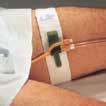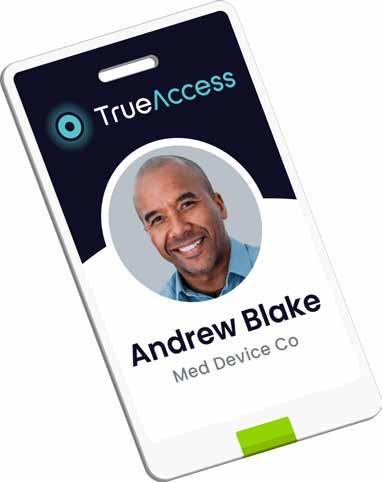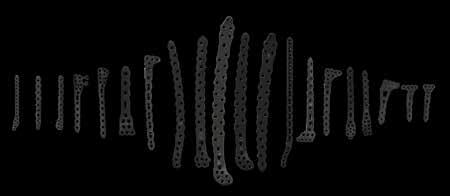























Recently I was on a trip with my 16-year-old daughter, Margaret. We were driving through the middle of nowhere Alabama on our way to visit a college in Mississippi, a state I had never visited. Thankfully the drive was uneventful. I was listening to a Grateful Dead concert on the radio and she was staring at her way-more-interesting-than-me iPhone.
That is, until she asked me a question about my work: “What is it that you do?”
I tried my best to explain that I publish a magazine for the
people responsible for acquiring everything a hospital system needs to give great care to their communities. It had been a long time since I had thought big about what our industry is. Honestly, I hate calling healthcare an industry. I like to think the Journal of Healthcare Contracting’s content humanizes our nation’s great IDNs, so Suppliers do their best to craft value for IDNs! After the conversation with my daughter, I thought more about why healthcare is so important to our lives beyond our corner of the market. Here is what I came up with, 5 interesting facts about healthcare in the U.S.
1. Hospital Employment: Hospitals are significant employers, with around 5.2 million people working in them in the U.S., making it one of the largest sectors for employment.
2. Economic Impact: Hospitals and health systems contribute significantly to the economy. In the U.S., they generate over $1 trillion in economic activity annually, making them crucial economic engines in many communities.
3. Patient Visits: On average, hospitals in the U.S. handle over 36 million admissions and nearly 140 million emergency department visits each year, highlighting their role as the backbone of healthcare delivery.
4. Healthcare Spending: Healthcare spending in hospitals represents a significant portion of national budgets. For example, in the U.S., hospitals account for approximately one-third of total healthcare spending, demonstrating their financial importance within the healthcare system.
5. Technology Adoption: Hospitals are increasingly adopting digital health technologies. As of recent years, around 90% of hospitals in the U.S. use electronic health records (EHRs), reflecting a significant shift towards digitalization to improve patient care and operational efficiency.
I could go on and on. A couple days later I tried to share this with Margaret to show her how important we all are! I don’t think it was completely lost on her, but her iPhone seemed more interesting. Maybe you can share these facts with your family on your long drive this summer.
Thanks for reading this issue of The Journal of Healthcare Contracting!

The Journal of Healthcare Contracting is published bi-monthly by Share Moving Media
350 Town Center Ave, Ste 201 Suwanee, GA 30024 -6914
Phone: 770/263-5262
FAX: 770/236-8023
e-mail: info@jhconline.com www.jhconline.com
Editorial Staff
Editor Graham Garrison ggarrison@sharemovingmedia.com
Senior Editor Daniel Beaird dbeaird@sharemovingmedia.com
Art Director Brent Cashman bcashman@sharemovingmedia.com
Publisher John Pritchard jpritchard@sharemovingmedia.com
Circulation
Laura Gantert lgantert@sharemovingmedia.com
The Journal of Healthcare Contracting (ISSN 1548-4165) is published monthly by Share Moving Media, 350 Town Center Ave, Ste 201, Suwanee, GA 30024-6914. Copyright 2024 by Share Moving Media. All rights reserved. If you would like to subscribe or notify us of address changes, please contact us at the above numbers or address.
POSTMASTER: Send address changes to
Share Moving Media, 350 Town Center Ave, Ste 201, Suwanee, GA 30024-6914.
Please note: The acceptance of advertising or products mentioned by contributing authors does not constitute endorsement by the publisher. Publisher cannot accept responsibility for the correctness of an opinion expressed by contributing authors.
QuidelOrtho has been dedicated to innovating a broad spectrum of respiratory testing solutions for decades. From rapid antigen to molecular, point-of-care to the lab, we’ve got you covered.


For more information, scan the QR code or contact a QuidelOrtho Account Manager at 800.874.1517
For more information, scan the QR code or contact a QuidelOrtho Account Manager at 800.874.1517
•Influenza A+B
•Influenza A+B
•Influenza A+B
• RSV
• RSV
• RSV
•SARS Antigen*
•SARS Antigen*
•SARS Antigen*
• Influenza A+B
• Influenza A+B
• Influenza A+B
• SARS Antigen*
• SARS Antigen*
• SARS Antigen*
• SARS Antigen+
• SARS Antigen+
• SARS Antigen+
•Influenza A+B
•Influenza A+B
•Influenza A+B
•RSV + hMPV
•RSV + hMPV
•RSV + hMPV
• SARS-CoV-2*
• SARS-CoV-2*
• SARS-CoV-2*
•Dipstick Strep A
•Dipstick Strep A
•Dipstick Strep A
•In-Line Strep A
•In-Line Strep A
•In-Line Strep A
• Strep A+
• Strep A+
• Strep A+
• RSV
• RSV
• RSV
• Flu + SARS Antigen*
• Flu + SARS Antigen*
• Flu + SARS Antigen*
• Strep Complete
• Strep Complete
• Strep Complete
• GAS
• GAS
• GAS
• Bordetella Complete
• Bordetella Complete
• Bordetella Complete
• Anti-SARS-CoV-2 Total*
• Anti-SARS-CoV-2 Total*
• Anti-SARS-CoV-2 Total*
• Anti-SARS-CoV-2 IgG*
• Anti-SARS-CoV-2 IgG*
• Anti-SARS-CoV-2 IgG*
use by authorized laboratories for the detection of proteins (QuickVue and Sofia) or nucleic acids (Solana) from SARS-CoV-2, not for any other viruses or pathogens. These tests are only authorized for the duration that circumstances exist justifying the authorization of emergency use of in vitro diagnostics for detection and/or diagnosis of COVID-19 under Section 564(b)(1) of the Federal Food, Drug, and Cosmetic Act, 21 U.S.C. § 360bbb-3(b)(1), unless terminated or revoked sooner.
*THESE TESTS ARE AVAILABLE FOR SALE IN THE US UNDER EMERGENCY USE AUTHORIZATION. These SARS tests have not been cleared or approved by the FDA, but have been authorized by the FDA under an Emergency Use Authorization (EUA) for use by authorized laboratories for the detection of proteins (QuickVue and Sofia) or nucleic acids (Solana) from SARS-CoV-2, not for any other viruses or pathogens. These tests are only authorized for the duration that circumstances exist justifying the authorization of emergency use of in vitro diagnostics for detection and/or diagnosis of COVID-19 under Section 564(b)(1) of the Federal Food, Drug, and Cosmetic Act, 21 U.S.C. § 360bbb-3(b)(1), unless terminated or revoked sooner.
*THESE TESTS ARE AVAILABLE FOR SALE IN THE US UNDER EMERGENCY USE AUTHORIZATION. These SARS tests have not been cleared or approved by the FDA, but have been authorized by the FDA under an Emergency Use Authorization (EUA) for use by authorized laboratories for the detection of proteins (QuickVue and Sofia) or nucleic acids (Solana) from SARS-CoV-2, not for any other viruses or pathogens. These tests are only authorized for the duration that circumstances exist justifying the authorization of emergency use of in vitro diagnostics for detection and/or diagnosis of COVID-19 under Section 564(b)(1) of the Federal Food, Drug, and Cosmetic Act, 21 U.S.C. § 360bbb-3(b)(1), unless terminated or revoked sooner.
How Grady Health System has enhanced visibility and efficiency in its supply chain.
BY GRAHAM GARRISON
Kevin Gordon gained his initial exposure to the processes and technologies used in the healthcare supply chain through organizations like HCA and Ochsner Health. Upon assuming the role of System Vice President of Supply Chain at Atlantabased Grady Health System, Gordon anticipated having access to familiar daily reports and data sets similar to those from larger health systems he had worked with previously.
However, he discovered that Grady’s data was scattered across multiple systems, inconsistent processes were in place, and there was no centralized dashboard with key performance indicators (KPIs) for assessing the current state.
Recognizing the need for improvement, Gordon assessed the situation and identified outdated technology, opportunities to optimize the operations and inadequate data management processes as the main challenges.
Over the past year and a half, Grady Health System’s supply chain has undergone a transformation, enhancing visibility and efficiency – a critical milestone for both the health system and Atlanta’s healthcare delivery network and safety net.
Located in the heart of Atlanta, Grady is a prominent healthcare institution with several remarkable features, Gordon said. It distinguishes itself through its exceptional trauma care, specialized burn center, stroke

expertise, and unwavering dedication to serving the greater Atlanta community.
Grady is the only Level 1 trauma hospital in Atlanta and has one of the highest volumes of patient flow through an ED in the country. “Whether it’s car accidents, construction accidents, gunshots, you name it, the worst of the worst comes to Grady,” Gordon said.
Added to the complexity of its mission is the recent closures of nearby hospitals. Last fall, Wellstar announced the closing of its Atlanta Medical Center (AMC). Although AMC was a Level 2 trauma hospital, Grady still had to absorb much of its patient flow. Prior to the AMC closure, another hospital closer to the airport shut its doors, which put a strain on access to care south of the city.
“Despite those closures, I would say that we at Grady have definitely stood up and responded,” Gordon said.
Like many healthcare organizations, Grady has encountered significant hurdles in its supply chain management, necessitating a thorough reevaluation to establish a more efficient, resilient, and standardized structure while advancing cost reduction initiatives.
“These obstacles encompassed the imperative of ensuring supplier resilience, optimizing staff and process performance through the adoption of best practices and KPIs, and harnessing the potential of the existing ERP system alongside healthcare-specific data,” Gordon said. By conducting a comprehensive assessment of the supply chain, Grady’s Supply Chain leadership aimed
Our commitment to sustainability is ingrained in everything we do. From using less plastic in our packaging to being the only supplier to offer a full line of IV solution and irrigation containers not made with DEHP or PVC, our focus is safety for the patient, clinician and the environment.
To learn more about how we can help support your health system’s sustainability and patient safety goals, please contact your local B. Braun representative.

to pinpoint areas requiring improvement and implement effective strategies to address them. Through these endeavors, Grady aimed to identify a partner capable of not only accelerating these initiatives, but also bringing expertise and analytics to bolster the resilience and efficiency of its supply chain operations, fostering better patient care and organizational outcomes.
Methodology and analytics has proven instrumental in expediting our organizational plan,” said Gordon.
This partnership has enabled Grady’s supply chain team to swiftly evaluate their organizational structure, processes, teams, and implement optimal practices across Procure-to-Pay (P2P), strategic sourcing/ value analysis, inventory management, and operational efficiencies.
“One of the most exciting features is Grady’s ability to monitor inventory performance across their entire entity, providing service level performance metrics at a departmental level down to individual units.”
Several key obstacles involved in improving supply chain efficiencies included:
Prioritizing clinical involvement.
Evaluating and implementing leading edge operational methods to minimize redundancy.
Cultivating a robust supply chain leadership team.
Aligning personnel with streamlined processes centered on patient care.
Enhanced data analytics and technological advancements.
Through the adoption of efficient supply chain management protocols and methodologies, Grady effectively pinpointed and eradicated expenses with manual or redundant procedures such as excess inventory and procure-to-pay inefficiencies, Gordon said. This led to significant cost savings and waste reduction systemwide.
Grady partnered with the Berkley Research Group (BRG) for the transformative work. “Adopting their Supply Chain
“Taking a proactive approach to addressing change management has been key to our success, allowing us to quickly realize tangible benefits for our organization,” Gordon said. “By leveraging BRG’s offerings and expertise, we have provided our team with a platform to pivot swiftly and facilitate staff adoption of optimal practices with agility and efficiency. Through this collaboration, we have streamlined our operations, enhanced our procurement processes, optimized inventory management, and improved overall operational effectiveness. The partnership with BRG has proven to be a strategic advantage, enabling us to accelerate our plans and drive sustainable growth.”
Grady’s Procure-to-Pay process and Two-Bin Kanban approach
Gordon noted two categories in particular where Grady was able to implement
cost-saving and time-saving tools – P2P and a Two-Bin Kanban approach.
In the P2P process, match exceptions can significantly disrupt operations and strain resources, particularly when they lead to credit holds and necessitate rework by accounts payable (AP) and purchasing staff. Match exceptions occur when there are discrepancies between purchase orders (POs), receipts, and invoices. These discrepancies may include incorrect quantities, prices, or items ordered, they often trigger credit holds, preventing payment to suppliers until the discrepancies are resolved.
To tackle these challenges, Grady’s Supply Chain and AP worked together with BRG implementing measures, leveraging analytics to assess and refine its approach to preventing match exceptions, and streamlining resolution processes. This involves enhancing data accuracy and visibility throughout the P2P lifecycle, swiftly detecting discrepancies, and addressing root causes in real-time. Fostering collaboration among AP, purchasing, and suppliers has been crucial in promptly resolving issues.
“Through these optimizations, we have significantly reduced rework, strengthened supplier relationships, and ensured the seamless flow of goods and services to support patient care,” Gordon said. “Our efforts have yielded impressive results, slashing outstanding match exceptions by 77% and improving the average invoice age by 33%.”
Additionally, Grady directed attention to enhancing the purchasing front end, aiming to bolster order automation and elevate electronic ordering by an impressive 45%. By concurrently reducing orders outside the item master (57%
reduction), they significantly boosted buyer efficiency, improving same-day processing of purchase orders, and enhancing throughput. Additionally, Grady instituted P2P performance KPIs that were powered by BRG’s Supply Chain Analytics, enabling daily monitoring of their productivity (% of orders placed the same day, daily package delivery rate) to ensure optimization and the delivery of top-tier service to the departments they support.
Grady also implemented the TwoBin Kanban approach in their nursing units. At first, they encountered numerous challenges and inefficiencies that required resolution, Gordon said. By collaborating with BRG supply chain consultants, Grady took a strategic pause to assess operational processes, staff flow/process, inventory flow and identify avenues for optimizing the Periodic Automatic Replacement (PAR) management process in alignment with patient care objectives. This collaboration involved leveraging the expertise of BRG’s supply chain professionals and molding Grady’s methodology, staff training, centralizing orders through LUM (low unit of measure), and performance analytics.
These tools and methodologies furnished Grady with invaluable inventory insights and highlighted areas for improvement that were not readily accessible through Grady’s ERP system, Gordon said.
“The BRG analytics inventory insights afforded us a health index KPI for each PAR location, offering invaluable guidance on necessary adjustments to align our inventory with patient care requirements,” he said. “For example, we were able to reduce the inventory days on hand by 54% and no move inventory by 45%.
Moreover, we are leveraging BRG’s Visual 2BK Insights Dashboard, equipping our inventory specialists with crucial insights into daily product performance. This allows us to identify areas of opportunity for PAR adjustments, highlights stagnant inventory that can be removed, and pinpoints instances of stockouts, prompting necessary PAR adjustments.”
sophisticated data analysis and a continued focus on data integrity, Grady attained a profound understanding of its supply chain dynamics, spanning from procurement to payment, inventory control, supplier evaluation, and logistics enhancement, Gordon said.
“By harnessing the power of analytics, we pinpointed emerging trends,
“By harnessing the power of analytics, we pinpointed emerging trends, detected patterns, and preemptively addressed potential bottlenecks in real-time, thereby streamlining our operations.”
One of the most exciting features is Grady’s ability to monitor inventory performance across their entire entity, providing service level performance metrics at a departmental level down to individual units, Gordon added. This capability will enable their team to proactively engage with nursing staff in PAR management, sharing KPIs and fostering more efficient and collaborative processes.
Analytics modernized Grady’s supply chain management, empowering them with insights and decision-making ability. Previously, Grady’s teams were limited by disparate datasets and the ability to download clean data.
For example, key data fields were previously not built within Grady’s item master which prohibited the ability to clearly analyze operational data across the entire supply chain. Through
detected patterns, and preemptively addressed potential bottlenecks in realtime, thereby streamlining our operations,” he said. These enriched insights facilitated prompt identification of underlying issues, leading to proactive corrective measures. Additionally, they facilitated continuous monitoring of performance metrics, enabling Grady to meticulously track key indicators and pinpoint areas ripe for enhancement, consequently optimizing our resource allocation.
Ultimately, Gordon said, analytics played a pivotal role in elevating the efficiency, adaptability, and resilience of Grady’s supply chain, “ensuring our ability to meet customer demands efficiently while minimizing expenses and maximizing value.”
Editor’s note: For more information on the Berkley Research Group (BRG), visit thinkbrg.com, or contact Joseph Arruda, Director, at jarruda@thinkbrg.com
The future of care delivery is undergoing a fundamental transformation to become patientcentric, virtual, ambulatory, home-based, and value-based. This transformation is driven by data and analytics and while it is integrated, it remains fragmented.1
As the possibilities for care continue to grow, so do the complexities of safeguarding the well-being of both business and patient health.
The rise of ambulatory sites reflects the shift in medical care from hospitals to outpatient sites. And while hospital care is still the largest healthcare market segment overall, ambulatory settings continue to see disproportionate growth.
Ambulatory market outlook2
Hospital outpatient departments and ambulatory surgery centers (ASC) will continue to experience patient growth (19% and 25% by 2029), with patient volumes projected to increase by 15 million from 2019 to 2029. In addition, the shift in procedures from inpatient to outpatient will help drive down the cost of surgical procedures
Physician clinics will see pronounced declines in in-person visits (-19%) as patients shift to virtual, but those patients seen in the office will be more likely to need specialized diagnostic services. Non-visit services in physician clinics, such as office-based diagnostics, laboratory testing, and imaging, are projected to grow 18% by 2029
What role does manufacturing play in meeting the needs of today’s ASC?
One of the primary concerns for ASC leadership is cost reduction, with a central focus on gaining control of their supply chain management. Medical supplies represent a significant portion of the budget, second only to staffing costs. Recent supply chain disruptions and escalating inflation have presented notable challenges. It is imperative for ambulatory centers to promptly address internal issues such as operational inefficiencies, high wastage, and excessive costs.
Because the supply chain function oversees most of a health system’s external spend, which accounts for up to 40% of total costs, working with a high-performing supply chain can boost resilience, enhance care and reduce supply
spend, placing ASCs in a better position to achieve growth goals.
Launched in 2023, Dukal InSight is a cross-functional effort to achieve combined business, IT, and planning benefits. It focuses on building connectivity and agility into supply chain operations to deliver adaptability, industry-leading transparency, and communication in combination with Dukal’s leading line of medical supplies. This allows for the identification of potential disruptions, maximizing customer efficiency, and avoiding costly delays and out-of-stock situations.
The solution integrates business planning, transportation, warehouse logistics, and customer collaboration to support growth goals, offering customers:
Real-time visibility to shipping and delivery schedules
Inventory assignment at the factory level, eliminating the industry practice of arbitrary allocation
Timely and collaborative communication to overcome disruptions before they impact business or patient health
Learn more at dukal.info/insight.
1 www.mckinsey.com/industries/healthcare/our-insights/the-next-frontier-of-care-delivery-in-healthcare
2 www.businesswire.com/news/home/20210604005089/en/Sg2-Impact-of-Change- Forecast-Predicts-Enormous-Disruption-in-Health-Care-Provider-Landscape-by-2029


Distributors and self-distributing health systems now have complete transparency of their Dukal products’ from purchase order to delivery.
Product Assigned at the Factory Level
Product Tracking at the Item Level
Compatible Excel Reporting
Automated Communication
Worldwide Tracking

Scan


Adrienne Ainsworth, Vice President Strategic Sourcing, Advocate Health
Sam Banks, Chief Procurement Officer, VP, Supply Chain, Indiana University Health
Dallas Brummell, Chief Operating Officer, Capital Division Supply Chain HealthTrust Supply Chain
Geoff Gates, Senior Director of Supply Chain Management for Cleveland Clinic
Trisha Gillum, Executive Director of Supply Chain and Materials Distribution, Kettering Health
Nestor Jarquin, Strategic Sourcing Sr. Category Manager, Surgical, Kaiser Permanente
Senad Odzic, Director of Supply Chain and Value Analysis, Rush University Medical Center
Paul Oppat, Executive Director Supply Chain Services, Banner Health
Doug Pytlinski, Senior Vice President of System Supply Chain, AdventHealth










































































































































TIME-TESTED, TRUSTED, AND TAILORED TO HEALTH SYSTEM AND GROUP PURCHASING NEEDS.
The numbers don't lie. Front Line Care at Baxter is a broad family of Welch Allyn products for examining, measuring, monitoring, screening, and diagnosing patient health. Experience the power of one Baxter with our physical exam and diagnostic solutions. LET'S INNOVATE THE EXAM ROOM TOGETHER WITH THE LATEST PHYSICAL EXAM TOOLS:



The numbers don't lie. Front Line Care at Baxter is a broad family of products for examining, measuring, monitoring, the of Baxter EXAM



Adrienne Ainsworth is the enterprise Vice President of Strategic Sourcing with Advocate Health, the fourth-largest nonprofit healthcare system in the United States, including 69 hospitals and over 1,000 sites of care. She is also the Vice President of Advocate Health Supply Chain Alliance (AHSCA), a regional group purchasing organization focused on bringing safe and effective products and services to its members at exceptional value. Ainsworth’s responsibilities include leading sourcing strategy and value analysis for supplies, implants, purchased services, pharmaceuticals, capital, and equipment planning.
Ainsworth also participates in several industry councils including the Milwaukee Anchor Collaborative focused on investing in disadvantaged and disinvested neighborhoods and businesses in the Milwaukee area, and she is a national Board Member of the Association for Health Care Resource & Materials Management (AHRMM) committed to advancing health through supply chain excellence.
As part of the Advocate Health Supply Chain cabinet, I have been laser focused on driving clinical quality, governance, and economic value across the new enterprise.
I successfully led strategic sourcing through the merge of Advocate Aurora and Atrium Health in December 2022, driving over $100 million in supplies, drug, and services annual savings within the first year. Leveraging my experience from the 2018 Advocate Aurora merger, I hit the ground running on day one, bringing together 30-plus Sourcing leaders virtually from Milwaukee and
Charlotte to assess and benchmark nearly $2 billion in legacy contract spend within the first week of the merger, identifying immediate synergy savings, and drafting the Sourcing roadmap for the next three years.
Supporting Advocate Health’s 22,000 aligned and medical staff physicians and 42,000 nurses, facilitating sound enterprise decision making on product and service strategy is both imperative and a substantial challenge. Through a survey of 600-plus key stakeholders, listening sessions with decision makers, and interviews with thought leaders across the industry, the Advocate Sourcing team stood up a comprehensive enterprise value analysis program to support Advocate Health and other AHSCA members. This program shifts the mindset from simply a cost-reduction vehicle to an inclusive, multidisciplinary, clinical/datadriven program for enterprise-wide assessment of new products and formulary opportunities that enhance patient safety and quality, clinical effectiveness, fiscal responsibility, and revenue growth opportunities. The program also leans into innovative technology to enhance supply chain stability and care delivery across the enterprise.
In September, AHRMM membership elected me as a provider representative of the 2024 advisory board. As AHRMM is a critical resource for advocacy and enhancement of healthcare supply chain issues, the advisory board opportunity allows me to serve the broader healthcare supply chain industry in setting strategic direction and influencing the next generation of supply chain professionals to advance health care through supply chain excellence.
Supply chain technology is evolving rapidly in the age of generative AI, machine, and deep learning. I’m thrilled to be exploring these capabilities with industry partners to address real-time use cases like acute labor



In this post-pandemic world, uncertainty is the new normal. Being resilient and ever-ready have moved from aspirational to table stakes. And now — more than ever — you need a reliable partner to support you and your patients every step of the way. That’s why we’re redefining supply chain expectations.
In this post-pandemic world, uncertainty is the new normal. Being resilient and ever-ready have moved from aspirational to table stakes. And now — more than ever — you need a reliable partner to support you and your patients every step of the way. That’s why we’re redefining supply chain expectations.
From physician offices to surgery centers and patients’ homes, we tailor our breadth of offerings to create a unique roadmap that helps you build a resilient, high-performing supply chain.
From physician offices to surgery centers and patients’ homes, we tailor our breadth of offerings to create a unique roadmap that helps you build a resilient, high-performing supply chain.



Redefining partnerships
We’re relentless about building trusted partnerships that make supply chain excellence and better health possible.
We’re relentless about building trusted partnerships that make supply chain excellence and better health possible.
We build customized solutions to help you improve operational, financial and clinical outcomes — efficiently, effectively and on budget — so you can deliver better patient care.
We build customized solutions to help you improve operational, financial and clinical outcomes — efficiently, effectively and on budget — so you can deliver better patient care.
Supply Chain Expectations, so you can deliver care – anywhere.
Raising Supply Chain Expectations, so you can deliver care – anywhere.
Redefining world-class distribution
Redefining world-class distribution
We’re ready for the future — today. From global distribution to logistics services, we help you improve operational efficiencies across hundreds of micro supply chains, so you’re ready to take on any challenge.
We’re ready for the future — today. From global distribution to logistics services, we help you improve operational efficiencies across hundreds of micro supply chains, so you’re ready to take on any challenge.
shortages, supply chain disruptions, and shifting business priorities. For example, leveraging transaction data, we now can identify the likelihood of a critical item backorder weeks before stockouts occur, enabling our organization to pivot to other products or clinical practices to minimize patient care and operations disruption. From a contracting lens, we are exploring tools that will help identify inherent risks and recommended mitigation strategies within hundreds of existing agreements, enabling our contracting team to better prioritize areas to shore up in the near term, and generate more impactful and risk-averse sourcing events moving forward. These promising technologies will enable healthcare providers to unlock a new level of efficiency and value within the supply chain.
What motivates you as a leader?
The most rewarding part of my work is having the great fortune of working with some of the most talented sourcing professionals in the industry. The level of professionalism, innovation, and high-quality execution within the Advocate Sourcing team is a strategic differentiator within our system. As a leader, building a supportive, empowering team culture requires intentionality and continuous improvement.
What’s the biggest takeaway for you as a supply chain leader over the last few years of marketplace disruptions?
Healthcare is experiencing a period of substantial transformation, managing through headwinds of inflation and global economic downtown, changing reimbursements tied to evolving healthcare policy, growing needs of an aging patient population, a shift of care further down the care continuum, ongoing supply disruption stemming from the pandemic, climate change, and geopolitical conflicts, and a dwindling and expensive labor pool. These factors, among others, have led to a period of mass consolidation of healthcare systems, and an urgent need for rapid cost containment and evolved productivity, while preserving and enhancing patient
Chains have the ability to thrive in an environment of constant change.
outcomes. Supply Chain services, now more than ever, is a critical factor in the success (or failure) of a provider’s ability to navigate these challenges. Some examples of SCM solutions include:
Combining and optimizing system strategies in supplies, capital, drugs, and services through contract enhancement, clinical standardization, optimal inventory management, right place right time pathways, and automation.
“Tip of the Spear” integration capability –accelerating synergy opportunities in M&A, evaluating and leveraging scale to drive supply savings opportunities to immediately drive down cost and promote enterprise integration.
Leveraging technology to harness EMR and ERP data to evaluate care variation analytics, facilitating peer-to-peer clinician discussions to share best practices, enhancing clinical quality, patient experience, and affordability.
Mitigating risk, enhancing response time, and reduce resource burden through supply resiliency strategy and agile inventory management practices and logistics approach.
Healthcare Supply Chain is a fast-paced, growing industry with successive career advancement opportunities, and many roles with attractive work-life balance benefits. Supply Chain professionals often interface with to the most influential leaders within the healthcare system; this unique platform positions Supply Chain as an “incubator” for young talent interested in expanding to other areas including finance, hospital administration, or quality.
Successful Supply Chains have the ability to thrive in an environment of constant change. I have found that an effective Supply Chain directly enhances patient care and clinician efficacy and safety through stakeholder and supplier partnership, bold and innovative program development, and a ceaseless passion for continuous improvement.
The role of supply chain has expanded, and your importance to health system operations is more critical than ever. The Allergan Aesthetics portfolio of market leading products delivers the value you expect from the industry leader.1,2,*

Choose the inventory solution that works best for you, and our team will help manage it through consignment, provisional stock, or direct purchase.

We’re here to help. Field sales, reimbursement experts, customer service professionals, and an experienced medical team are all standing by to assist every step of the way.
*Based on surgeon survey data. Natrelle ® (n = 516); AlloDerm™ (n = 203); Keller Funnel (n = 299); REVOLVE™ System (n = 98); STRATTICE™ (n = 147).1,2
References: 1. Data on file, Allergan Aesthetics, March 2024; Plastic Surgery Aesthetic Monthly Tracker. 2. Data on file, Allergan Aesthetics, July 2023; Surgical Scaffold AU Surgeon Perceptions 2023. 3. Data on file, Allergan Aesthetics, January 2022; Allergan Plastic Surgery Order Form. 4. Data on File, Allergan Aesthetics, January 2023; AlloDerm SELECT Ordering Information. 5. Data on file, Allergan Aesthetics, July 2023; Artia Ordering Sheet. 6. Data on file, Allergan Aesthetics, January 2023; STRATTICE Ordering Information.
Follow us on LinkedIn and stay

Allergan Aesthetics products offer a wide range of SKUs tailored to meet surgeons’ diverse needs.3-6
Learn more about partnering with us. Call 1.800.367.5737 or Email PRMorder@allergan.com

As the Chief Procurement Officer and Vice President of Supply Chain for Indiana University (IU) Health, Sam Banks is responsible for $1.2 billion in annual spend, 550 people across 16 hospitals, numerous Ambulatory Surgery Centers (ASC) and their 296,000 square-foot Integrated Service Center (ISC). The main functions under the Supply Chain umbrella include Hospital Operations, ASCs, Warehousing, Distribution, Purchasing, Strategic Sourcing, Value Analysis, Program Management, Operational Excellence, Business Analytics, Fleet Management and Freight.
Any recent stories of successful Supply Chain projects you can share?
Over the past year, we created a five-year strategy. In 2023, we completed 19 projects to bring this strategy to life, marking a notable step in our journey toward transforming our Supply Chain. As we move into 2024, we continue to progress our strategy, with 14 projects completed year-to-date.
IU Health is on target to increase the number of items sourced from the ISC by 20% in a single year. Also of note, we have established robust business reviews with our key suppliers with a focus on listening to what our suppliers have to say, working together to solve problems and being more innovative.
Part of the strategy is utilizing WaveMark, which will be fully implemented in our large hospital ORs by early 2025. This will provide point-of-use data on our high-cost procedural area supplies, enabling enhanced data-driven waste reduction, expiration management, and par level optimization. In all, over
200 ORs and Endo procedure rooms will utilize WaveMark for IU Health helping us drive a multimillion-dollar return.
What about upcoming initiatives you are excited to be working on?
We are in the second year of our five-year strategy, and it is exciting to see our initiatives and hard work starting to yield dividends. I am especially excited about our initiative to double the throughput at the ISC in the coming years. This will dramatically improve our risk profile, reduce lead-time, drive efficiencies, and improve our cost profile.
IU Health continues to invest in its most valuable resource, its people. With that in mind, our “Future Vision” statement in Supply Chain is for the people foundation project which highlights our intent for people and leadership development over the next few years, creating a highly skilled, innovative, disciplined, accountable, empowered, diverse and engaged team. Working with our HR partners, we measure employee retention, and
We need to be asking the right questions to our suppliers. We need to have a better understanding of our total supply chain network – going beyond an understanding of the Tier 1 level.
collect responses from Gallop Employee Engagement surveys at the end of each quarter regarding employee satisfaction.
How do you measure the success of your team and its impact on the organization as a whole?
Our success comes in the form of every patient being treated, without delay, and with the needed device or supply. Our top goal is to be a trusted partner in patient care. Our clinicians should never have to worry about supplies. As we achieve this goal, we will provide a sustained advantage for IU Health and support our unique role in Indiana as the preeminent academic medical system. Our current measures include critical operational drivers, such as zero stock outs, percent of supplies managed at the ISC, collecting quality data to reduce price/OUM/part number exceptions, and fill-rates. We lead procurement efforts to manage inflationary pressures and reduce the total cost of care. We also support critical clinical initiatives like utilization and standardization programs.
What’s the biggest takeaway for you as a supply chain leader over the last few years of marketplace disruptions?
As Supply Chain professionals, we need to be curious. We need to be asking the right questions to our suppliers. We need to have a better understanding of our total supply chain network – going beyond an understanding of the Tier 1 level. Discussions around risk mitigation and supplier resilience needs to be part of the daily job and not once a year or one-off event.
What are the most important attributes of a successful supply chain team today?
We must continue to evolve, ask questions, be curious and enthusiastic around improving. Communicate within our team, all of IU Health and our external contacts. Problems arise. Being able to solve those problems efficiently either alone or with a team is key.
What are the keys to a successful provider/supplier relationship?
At IU Health, we believe we need to have a much more transparent relationship with our suppliers. We have opportunities to improve through open communication with our suppliers. Any inefficiencies driven into the supply base can be corrected with honest conversations and collaboration. When our suppliers gain an understanding of our strategy and what is important to us, they in turn are able adjust their focus and plans for mutual success.
In the dynamic landscape of healthcare services, managing purchased services –those provided by outside companies – is paramount. Benchmarking plays a crucial role in this process by applying a disciplined approach to negotiating pricing, service level agreements (SLAs) and contract terms and conditions.
Purchased services are critical to healthcare operations – encompassing a wide range of outsourced services such as language interpretation, laundry and linen, security and hundreds of other categories. We select categories for Power Benchmarking based on provider feedback, overlapping initiatives, and/or top spend categories to solicit agreements and pertinent information from health systems and Valify subscribers. Our team reviews and processes this information to provide a customized report tailored to the health system’s performance in relation to its peers.
The primary goal of Power Benchmarking is to gather and analyze various data within pre-selected categories of purchased services. The analysis enables healthcare organizations to:
Identify Price Ranges: Power Benchmarking delves into the pricing structures of healthcare organizations and their peers, enabling them to gauge competitiveness and negotiate effectively with vendors.
Uncover Metrics around SLAs: SLAs are crucial to ensure quality and reliability. Power Benchmarking captures and compares SLAs, offering insights into industry standards and performance expectations.
Determine Best Practices: By studying best practices adopted by top performers, healthcare providers can learn and implement strategies that drive efficiency and quality.
Assess Terms and Conditions: Valify reviews agreements across different suppliers and hospitals to identify contract terms and conditions prevalent in a given category. This analysis aids in structuring contracts that are fair, comprehensive, and aligned with industry norms.

By Ben Bailey, Director of Benchmarking, Valify
Power Benchmarking returns value to healthcare organizations in three ways:
Cost Savings: Comparing prices allows healthcare organizations to identify cost-saving opportunities and negotiate competitive contracts.
Improved Quality: By adopting industry best practices and leveraging SLA metrics, healthcare providers can enhance service quality and patient satisfaction.
Enhanced Vendor Management: Clearly defined contractual terms and conditions gets everyone on the same page and supports healthy relationships with vendors in managing contracts efficiently.
Healthcare organizations need to work with a partner in purchased services solutions that offers Power Benchmarking. Participation in this program helps providers optimize cost management, quality and vendor relationships. By leveraging Power Benchmarking, they can navigate the complexities of outsourcing services effectively, ultimately leading to improved operational performance and better patient care.
If you want to enhance your organization’s efficiency and effectiveness in purchased services, participation in Power Benchmarking is one way to do that.
To learn more about how Valify can help achieve your goals in purchased services, with an average savings of 10%-30%, or to inquire about participation in Power Benchmarking, email us at info@getvalify.com


HealthTrust Performance Group solves the toughest challenges by leveraging our decades of senior level healthcare experience to optimize clinical and operational performance while providing unmatched savings. Its a difference only HealthTrust can make.

Dallas Brummell currently serves as the Chief Operating Officer for HCA Capital Division Supply Chain. Brummell is responsible for all Supply Chain operations for the division, covering (15) hospitals across (18) campuses and (9) associated free-standing emergency rooms, (2) distribution warehouses and (1) medical equipment depot. He coordinates with Supply Chain functional area leaders that include Clinical Excellence, Contracting, Pharmacy, Procure to Pay and Support Services to assist in leading a team of HealthTrust professionals in the movement and availability of all supplies, equipment, and overall support for their hospitals and care providers.
Any recent stories of wins/successful Supply Chain projects you can share?
Two come to mind:
Supply Chain & PPR (Physician Provider Relations) Engagement: Facility/Hospital collaboration between PPR and Supply Chain leadership is vital. A structured, on-going forum to review new technology, equipment, supplies and contracting needs for our providers as they onboard and/ or expand services in our hospitals and communities supports them in providing high quality care.
Equipment Shared Services: While we currently manage mobile medical equipment in our central and northern Virginia hospitals, we are
expanding our equipment management model to our hospitals in southwest, Virginia, New Hampshire and all associated Free-Standing Emergency Departments. Using RFID technology, data analytics, and equipmentfocused leadership, mobile medical equipment is readily available when needed, has increased visibility by the caregiver, and allows for streamlined inventory management across our division.
What upcoming initiatives are you excited to get started on?
We are very excited about our Service Line Engagement Initiative; specifically partnering with service line leaders and clinicians in our Operating Rooms, Cath Labs and Interventional Labs, to better understand their needs as they relate to patient care: equipment needed, new technology, first-to-market and new services for the community.
We are also excited about technology upgrades and integration of AI into our systems.






























































































































































Capital Division is in the middle of upgrading our warehouse inventory management technology. With AI integration and the ability to analyze historic data, this technology will assist in supply/demand forecasting and will ultimately optimize our overall Supply Chain. We have already instituted AI in requisitioning of replacement equipment parts; more specifically, automating the review of SKUs across multiple item catalogs to identify the most readily available items at the best price for our hospitals. AI is an area that we are very excited about expanding to additional functional areas of our Supply Chain over the next few years.
How do you measure the success of your team and its impact on the organization as a whole?
In my mind, success is our clinical teams having quality, cost-effective supplies, equipment, and service that allows them to provide exceptional patient care. HealthTrust’s ability to add value and expand our scope of service each year is one of our key strengths.
What’s the biggest takeaway for you as a supply chain leader over the last few years of marketplace disruptions?
It is of the utmost importance to expand our vendor network and relationships and ensure that supply contingencies are in place. We, as an organization, have looked at sourcing differently over the last few years post-pandemic; understanding that we need to have multiple ways to source critical supplies and equipment.
What are the most important attributes of a successful Supply Chain team today?
A successful Supply Chain team is adaptable and can move together with the market and/or an
Our goal is to support our care providers in a way that allows them to spend more time at the bedside with their patients.
unexpected event to provide exceptional services in the midst of change.
From a service-level perspective, our Supply Chain teams understand their impact on our patients and care providers daily. Every functional area makes a difference; from warehouse distribution, technicians stocking clinical units in our hospitals, to contracting and value-based clinical initiatives. Our goal is to support our care providers in a way that allows them to spend more time at the bedside with their patients. Our ability to have the right supplies and equipment, in the right place, at the right time is imperative to achieving that goal and allowing our clinical teams to focus on their mission.
From a financial perspective, the ability to invest funds into new technology, equipment, and hospital infrastructure is imperative. In order to support the growth at our facilities approach, our Supply Chain teams review savings initiatives through value analysis, contracting/sourcing, rental expense reduction, prompt payment discounts and operating efficiencies.
What are the keys to a successful provider/supplier relationship?
Transparent communication with our suppliers and the ability to monitor and/or measure vendor/supplier performance across our functional areas; via monthly and quarterly business reviews. Understanding potential supplier risks and external threats to our suppliers is extremely important. The pandemic was certainly an eyeopening time for many organizations; specifically related to the overall inability to provide goods/ services. In our world, these goods and services still need to be available for our clinicians to provide care for our patients. Today, more than ever, we and our vendor partners understand the importance of having sourcing contingencies and the ability to pivot amongst our contract portfolio to make sure we are providing quality products timely for our care providers – regardless of external factors.
DETECTO manufactures more unique models for each clinical product category than any other medical scale company. Giving you better choices means you never have to settle for a product that isn’t the right fit for your application.
DETECTO: A true vertically-integrated medical scale manufacturer – family owned and privately held – with factory and headquarters in Webb City, MO.
The Best Choice is the One That Gives



Geoff Gates leads the P2P and Technology division within Cleveland Clinic’s Supply Chain and Support Services, which encompasses Data Management, Analytics, Purchasing, Technology and Resiliency. His team supports the enterprise, managing operations in Ohio, Florida, and Nevada within the U.S. Additionally, they collaborate closely with on-site teams in the UK to support their day-to-day requirements.
What’s a recent win for your Supply Chain team?
Last October, we successfully completed our 3-year deployment of a Cloud-Based ERP; this involved consolidating 5 ERPs into one across Ohio, Nevada, and Florida. During this period, we also opened hospitals in the UK and Northeast Ohio. We also completed a similar deployment for our food service division, standardizing our main application for nutrition and meal delivery. These initiatives have helped us create a global model for operations in both the U.S. and UK.
Additionally, we unveiled plans to incorporate drone technology for pharmacy deliveries in 2025, rolled out multiple automations (bots) last year, implemented a warehouse management system and recently completed an upgrade to our e-procurement tool, which encompasses marketplace shopping, supplier management, and contracting.
What about upcoming initiatives you are excited to be working on?
There are two specific initiatives we’ve been focused on this year. First, given the ongoing emphasis on supply chain resilience, we’ve been actively
seeking a solution that will help create end-toend supply chain visibility. This involves sharing our procedure schedules, daily census, on-hand inventory, and forecasts with suppliers, while also asking suppliers to provide insight to their forecasts and on-hand inventory. Creating that visibility would be a crucial advancement toward greater resilience, enabling us to anticipate disruptions more accurately.
That leads to our second initiative, centered on the integration of AI in our operations. We’ve been working with our teams to better understand potential use cases and areas where AI could drive improvements. We’ve also started outlining what existing tools we can leverage and identifying additional resources we may need as we further expand AI integration into our operations.
How do you measure the success of your team and its impact on the organization as a whole?
Over the last few years, much of our focus has revolved around making sure we meet our
To say that the last few years have been challenging would be an understatement, and we’ve learned how interconnected we all are. At the same time, it has challenged us to think differently about what it means to be resilient, paving the way for enhanced collaboration within the industry.
implementation timelines. As we move forward, our focus shifts toward identifying and implementing efficiencies. Whether it’s through an enhancement to our systems or introducing new automation, our team has the potential to significantly impact the organization.
The U.S. healthcare system has had its share of disruptions amid the pandemic and now post-pandemic. What are your takeaways as a Supply Chain leader?
In short, expect the unexpected. To say that the last few years have been challenging would be an understatement, and we’ve learned how interconnected we all are. At the same time, it has challenged us to think differently about what it means to be resilient, paving the way for enhanced collaboration within the industry. The enhanced partnerships that exist today between providers and suppliers are one of the biggest achievements following the pandemic.
What are the most important attributes of a successful Supply Chain team today?
Two key attributes immediately come to mind. The first is being agile. In today’s healthcare landscape, priorities are constantly shifting and evolving. You need to be flexible enough to recognize when to pivot, while simultaneously staying focused on core competencies. This is one of the things I am most proud of with my team over the last couple of years as we were able to not only complete our core focus of ERP deployments but also prepare for the future by integrating automation and AI.
The second is embracing data and technology. We have more data now than we’ve ever had and are migrating to tools that rival other industries. Successful teams will be those capable of leveraging data for decision-making and utilizing technology to enhance operational efficiencies.
What are the keys to a successful provider/supplier relationship?
In a word, it’s transparency. Both parties must be willing to openly share information and details so that we can better serve patients together. Collectively, we are better off working together to solve our issues and transparency is the key to that.

Trisha Gillum, Executive Director of Supply Chain and Materials Distribution, has extensive experience in health care finance and operations, including roles in general accounting, decision support, third party contract management, revenue cycle management, and perioperative operations management.
Please tell us a little bit about your role and responsibilities.
I’m Kettering Health’s executive for Supply Chain management, which includes value analysis, product sourcing, contracting, the MMIS system, purchasing, and operations. On the operations side, that includes receiving, inventory management, courier services, linens, and our in-house print shop. I also manage acute and non-acute spend.
Any recent stories of wins/successful Supply Chain projects you can share?
I’m excited by our recent success in the PPI, or physician preference items. We’ve been working with our physicians to standardize product selection, driving towards one or two primary vendors, with limited access to niche products as needed, for patient care. Pursuing this will drive significant financial benefits, as well as operation benefits, by limiting the number of vendors with products on site and the number of systems our clinical teams need to know. One of our most successful examples was our spinal implants: We were able to go from about 18 vendors to two primary vendors. These changes
really allow us to pick our partners and focus on clinical expertise.
What about upcoming initiatives you are excited to be working on?
We recently converted our group purchasing organization to Vizient, and we’re looking to optimize opportunities through that platform. Moving to Vizient was a year-long process, where we really assessed where we wanted to go and completed an implementation and initial conversion earlier this year. With this in place, we can focus on taking advantage of what they have to offer.
And we are always looking at operational efficiencies, assessing practices across our operations.
How do you measure the success of your team and its impact on the organization as a whole?
Kettering Health monitors the success of individual cost initiatives, but we do also look at the overall supply spend of the system as a whole. We work
Adaptability has been a keyword during these times of disruption. I’ve learned that understanding what the needs are, where the critical needs are, and how we create risk strategies to minimize failure points in those critical needs is paramount.
very closely with our clinical and quality teams to monitor clinical performance and how our supplies impact overall patient quality.
What’s the biggest takeaway for you as a supply chain leader over the last few years of marketplace disruptions?
Be flexible, be flexible, be flexible! Maintaining good relations with our clinical team allows us to partner together to be flexible around what we can get and what we can use.
Adaptability has been a keyword during these times of disruption. I’ve learned that understanding what the needs are, where the critical needs are, and how we create risk strategies to minimize failure points in those critical needs is paramount.
What are the keys to a successful provider/supplier relationship?
Open and honest communication is so important for me. When I think back to the most successful projects and most successful relations, they were
really built around knowing that we’re functioning as a team where we can express needs, concerns, and issues. And our providers and suppliers kept us informed of any issues and needs they had. We worked to create a win-win environment where we could both be successful.
When a vendor lets me know something isn’t working as expected, it allows me to assure our team that a fix is in place and we can move forward. I really value transparency from our vendors.
As a faith-based, nonprofit health system, Kettering Health strives to improve the lives of people in the communities it serves through healthcare and education. Kettering Health is made up of 14 medical centers and more than 120 outpatient locations throughout western Ohio, as well as Kettering Health Medical Group – with more than 700 board-certified providers dedicated to elevating the health, healing, and hope of the community. Kettering College, a division of Kettering Health Main Campus, is a fully accredited college that specializes in health science education.
For more, visit ketteringhealth.org.

Strategic Sourcing Sr. Category Manager, Surgical, Kaiser Permanente
Nestor Jarquin is part of the Supply Chain Services organization at Kaiser Permanente, leading surgical sourcing for the direct spend sourcing team. He oversees sourcing for most of the company’s basic surgical equipment, except for specialty products used for orthopedics, spine, and cardiology. Jarquin manages several teams that are responsible for reviewing specific products and product categories to ensure that sourcing decisions are aligned across different areas of the organization. He has been with Kaiser Permanente for almost 17 years.
What got you interested in a career in Supply Chain?
My role today is different than when I first started my career in Supply Chain. Initially, I was a director in hospital-based materials management.
Instead of executing contracts or handing up contracts to clinicians and saying, “Hey, here’s the new glove you have to use,” I enjoyed experiences where I worked alongside physicians or clinicians to understand their requirements,
We asked our vendors to be fully transparent with their costs, including extricating overheads, shipping, and profit from line items to get true line-item pricing.
source products that aligned with their needs, and executed a plan. Unbeknownst to me, that really was how Kaiser Permanente operated. I had an opportunity to work this way in one of my prior roles and had enjoyed it. I worked with a surgeon, sourced alongside them, sat in on cases, and was able to see first-hand that side of the business. I went back to my day job and thought, “I’m not having fun with this anymore. I really want to try that.”
So, I found a position at Kaiser Permanente in Supply Chain, which is really the other side of the spectrum. What I appreciate most is the connectivity to physicians and clinicians, and driving quality together. This makes my role more meaningful because we’re focused on the patient.
What are some recent projects that have crossed the finish line and been deemed a success for Kaiser Permanente?
My most memorable project was creating a new business model for surgical custom packs.


Henry Schein Medical has the resources and expertise to align your entire network.

• Non-acute distribution model designed for price transparency and efficiency
• Customized and collaborative approach to growth and standardization delivering clinical, operational, and financial benefits
• Clear sight lines to drive visibility across the entire non-acute continuum
• Cost containment strategies and opportunities for savings across the network without compromising quality patient care
• And more
Learn more about Henry Schein ALIGN by contacting your Henry Schein Medical Business Development Executive or visiting henryschein.com/ALIGN
We are now taking a holistic perspective and looking at utilization, instead of purchase. With our collaborative model working with clinicians from beginning to the end, we share the data, the category, and have a discussion about the opportunities.
When we analyzed value and costs related to how each manufacturer put their line items in the pack, we were able to create a model that worked for the market. We asked our vendors to be fully transparent with their costs, including extricating overheads, shipping, and profit from line items to get true line-item pricing. And, working with our vendors, we’ve been able to create a model where we now have transparency – we know the line item costs for each pack, and have a collaborative relationship with our vendors.
In our new vendor contracts, we look at KPIs and SLAs that encourage this mentality. Our custom pack now drives efficiencies, both cost and environmental, in terms of waste. This was an evolution and industry shift in custom packs. Our vendor now uses this model with other customers. It was a situation where
the market really didn’t lend itself to driving efficiency, so we had to work closely to help make a shift.
We are now taking a holistic perspective and looking at utilization, instead of purchase. With our collaborative model working with clinicians from beginning to the end, we share the data, the category, and have a discussion about the opportunities. Quite naturally in those discussions, clinicians realize that they wish we would use more of this than that, or that we used this technique instead of that technique. So, what we’ve launched over the last few years is a new process called value-based use, where we can look at a category and drive efficiencies that improve quality and reduce cost.
We are also taking a close look at utilization, beyond purchase costs, because quite honestly, your purchase data is an after effect. It’s the utilization in the OR that is where your cost is – what is brought into the OR and what is used in a particular case. The alignment with our clinicians and physicians allows us to effectively pursue these utilization opportunities.





Senad Odzic is the Director of Supply Chain and Value Analysis at Rush University Medical Center in Chicago.
Your team at Rush collectively saved over $6 million in less than 10 months. Tell us why that was such a big win.
I started at Rush about a year ago, coming over from another IDN in the Chicago area called Endeavor Health, and saw an opportunity to make an impact on our savings.
Looking at the categories and the IT department, there was a lot of opportunities for savings, and we redid our agreements. We looked at licensing and where we could reduce our amount of spend. We also found opportunities in purchased services with linen and made sure to use local, diverse suppliers. Finally, we found opportunities in capital to renegotiate some pricing.
That’s the 30,000-foot view.
Looking at the present and into the future with sustainability and local suppliers, are there any specifics or big goals you have?
We support DEI (diversity, equity and inclusion) and sustainability initiatives at Rush and a lot of our spend is with local suppliers. Our goal is to enhance conversion and give local suppliers more opportunities to sell all of their products at Rush to help our local community, businesses and patients.
We partner with the Fillmore Organization in Chicago, which is about three miles away from Rush, for linen. Filmore built a new factory we were the first one
to sign an agreement with them. It’s a womanowned business and hires local employees. About 60 to 100 jobs are being created because of this. Previously, we would get our linens from Wisconsin, but now there will be less trucks on the street and less gas pollution. It’s a big part of our sustainability and diversity initiatives. We’re big on trying to source locally.
Talk about empowerment at Rush and giving your team the green light to do things.
I’m big about giving my team the power to seek out opportunities themselves for Rush, think about them and come together to discuss them. My goal for my team members is to grow and learn. If I tell them what to do, they’re not thinking for themselves, and I want them to look for opportunities at what could be done differently. We then come to the drawing board and discuss whether it makes sense or not.
Empowerment gives my team members a lot of different opportunities to come up with solutions to talk about. I don’t micromanage. I don’t believe in it. Then I’m doing their job and what’s the point in that?
There are so many local, diverse organizations that can bring opportunities to your organization, but you may not recognize it. If you go with large suppliers, they have a big corporate strategy, but local business owners, if you give them the opportunity to sell their products, are here and want to be successful.
They must grow and learn and make different decisions. Sometimes, we decide even if they’re wrong, that’s okay. But how do we learn from those decisions? What do we take from it in the future to not make the same mistake?
What does that look like leading a team in a post pandemic environment?
Being resilient. You have to be open to different things. You can’t be close minded, and you must think outside of the box to get different things worked out with suppliers.
Taking care of our patients is our top priority. That’s what we’re here for and we have to provide them with a quality of service that needs to be resilient and open to different kinds of thinking to get the job done.
That’s how I look at resiliency.
Expand on the impact that diversity and local suppliers have had at Rush. I’m a big believer in diversity. I’m from Eastern Europe and the former Yugoslavia.
Coming to the United States 30 years ago was different and I learned how to adapt.
There are so many local, diverse organizations that can bring opportunities to your organization, but you may not recognize it. If you go with large suppliers, they have a big corporate strategy, but local business owners, if you give them the opportunity to sell their products, are here and want to be successful. They want to grow here. That’s important to me.
What are keys to a successful provider-supplier relationship today beyond price?
Every organization has to make its numbers, but it’s also about building relationships with suppliers into partnerships. I look at it as a long-term partnership in growing the business.
How are we going to grow, become more innovative and bring in different products or services?
You have to be strategic in your thinking. Partnering with suppliers is about understanding what’s new, how to develop it, how to come up with new ideas and how to bounce back with those suppliers who’ve become partners, especially with the local suppliers.
We try to help the local, diverse suppliers come up with different products that are even better than the national suppliers can provide.

Banner Health’s corporate strategy includes the concept of “One Team” – enabling strong teams to deliver reliable care. Supply Chain Services (SCS) expands on that concept with a motto of “One Team – One Supply Chain”, said Paul Oppat, Executive Director Supply Chain Services, Banner Health. “We have organized our SCS team into segments that align with stakeholder priorities and needs.”
Oppat said he has “the pleasure” of leading the Operations segment of Banner Health’s SCS team. The Operations segment consists of hundreds of talented individuals who form workgroups in Procurement, operate a Consolidated Service Center and a dedicated Logistics Center, and deliver 24/7 services to customers in 30 acute care hospitals and to hundreds of clinics and health centers in six states. Oppat is responsible for ensuring the timely and efficient execution of our supply chain strategy to the point-of-use.
“We have a talented team, which makes my role easy.”
We recently completed a multi-year project to improve core functionality and reliability within the applications we use in our procure-to-pay cycle. We partnered with external and in-house talent to implement new applications, analytics, and workflows to better visualize Supply Chain performance, and to ensure the procurement process is aligned with formulary and sourcing strategy.
We also enhanced connections with clinical systems to provide better real-time data from an expanded item master that is supported by a new contracts database. We are pleased with the improved results we are experiencing in Supply Chain performance, clinical documentation, and in the revenue cycle.
What’s coming up on the calendar that you’re excited to work on?
We pride ourselves on being a clinically integrated Supply Chain team. That means not only focusing on the cost of care, but also the culture of care. We are renewing our commitment to promoting a culture of safety and embracing high reliability principles.
This year we are educating our team members on what it means to be a high reliability organization (HRO), and how they can align with those characteristics and behaviors in their Supply Chain role.
The U.S. healthcare system has had its share of disruptions amid the pandemic and now post-pandemic. What are your takeaways as a Supply Chain leader?
It seems marketplace disruptions are the new normal. We are experiencing a less predictable global economy fueled by the lingering effects of the pandemic and geopolitical turmoil. Supply disruptions are common and sometimes impact the quality of care.
My takeaway: be prepared.
Supply Chain disruption is not only likely, but certain. We must balance the need for an efficient Supply Chain with one that is more resilient and capable of consistently delivering despite these disruptions. We must change how we measure efficiency in a Supply Chain to enable increases in resilience and preparedness.
We must balance the need for an efficient Supply Chain with one that is more resilient and capable of consistently delivering despite these disruptions. We must change how we measure efficiency in a Supply Chain to enable increases in resilience and preparedness.
What are the most important attributes of a successful Supply Chain team today?
Our SCS team has five goals that support Banner’s overall strategy:
Make healthcare more affordable.
Increase supply chain efficiency.
Improve the customer experience.
Ensure Supply Chain Services is a great place to work.
Drive community health and well-being.
Everything we do fits within one or more of those goals, and we have ongoing and annual objectives to support those goals.
A successful Supply Chain team understands the need to go beyond the cost-to-serve; we must remember we are people serving people. Great outcomes come from great teams of individuals who do meaningful work, together, that makes a difference. Obvious and plentiful teamwork is the attribute I admire most in a successful Supply Chain team.
How does a high-performing Supply Chain benefit the overall organization?
Like our peers in this industry, we have many key performance indicators (KPIs) we use to track performance over time. Our goal is simple: to do things better today than yesterday.
Beyond the numbers, our influence in the organization is probably the best measure of our overall performance. Are we proactive or reactive?
Are we part of the development of strategy, or are we simply a business unit that executes strategy developed by others? Being viewed as trusted business partners who add value; that is my KPI.
How should suppliers approach their work with today’s health system supply chain teams?
Providers and suppliers trade in a challenging space. In healthcare, the customer seems obvious – the patient. But some might consider the customer to be a caregiver, or a payer. Value goes beyond price, and both providers and suppliers are challenged to find a balance of when and how we measure value for various stakeholders.
A great provider/supplier relationship exists when we can trust one another to openly discuss where we both add or subtract from the value chain, and when we work together to make things better, for the patient.

As the Senior Vice President of System Supply Chain for AdventHealth, Doug Pytlinski serves as leader over Supply Chain operations across AdventHealth, including acute and non-acute operations, the value analysis teams, and distribution and logistics, which now includes a new Consolidated Service Center (CSC). Pytlinski also leads the Supply Chain strategic sourcing group, which manages the sourcing and contract management for AdventHealth and AdventHealth Supply Chain analytics, reporting and their affiliation program. This work includes more than 50 hospitals across nine states with about $2.5B in supply spend.
What’s are some recent Supply Chain “wins” you can share?
Our new CSC is an expanded asset for AdventHealth that will allow us to build a more resilient process and provide a tool that can help limit the impact of future disruptions through various inventory strategies. We have also teamed up with our distributor partner, Medline, to create something that will address not only the present but will also set our health care system up well for the future. Providers have looked at and done CSCs in the past, though the approach AdventHealth is taking through the partnership with Medline sets AdventHealth up for success. By partnering with Medline, we are building in resiliency with a leading partner in this space. AdventHealth will own the business, strategies and inventory, and Medline will provide support in three key resiliency areas -- staffing, inventory backup and transportation. As the AdventHealth CSC supports our 30+ hospitals in Florida, we need to ensure we can perform the services
even if something happens to the building, our people or our fleet of trucks.
Value analysis is a key aspect in any Supply Chain, and AdventHealth is no different. This space continues to evolve as we look to various leader and clinical partnerships, process improvement and introduction of tools to help us better assess our clinical products. With the reorganization that took place in the middle of last year, our value analysis team brought our corporate and market value analysis teams under a single structure and leader. This has allowed for a more streamlined process for reviewing, evaluating and implementing work across our system and supporting the contracting teams from a clinical perspective.
At AdventHealth, our people are our greatest asset. It is important that we provide growth plans for our team, offer cross-training opportunities and grow our team members internally as a priority. As an organization that spans the country, we are continually looking for ways to engage with our teams both virtually and in person. Through our annual Supply Chain Summit, we have been able to engage with leaders to ensure alignment on strategies and to look at where we are going in the future. Our latest endeavor is the creation of a formal development program, where we are looking to take internal talent and prepare them for future roles and growth opportunities.
I am most excited about three things:
First, as we partner with Workday, we are designing how our Supply Chain will operate for the next 15 years and beyond. Part of this work will look to align and tighten the processes in Supply Chain across our system, while creating a framework for us to continue to challenge how we mature as a system in this space.
Second, I am excited about building out our inventory management team and our inventory
control tower approach development. This work is all about visibility and allowing our front-line team members to focus on the work at hand, while we have a key group acting as a central resource to monitor and provide our facility teams with key insights into their inventory demands and forecasting. Health systems are full of data, and it is the ability for a health system to tap into this data and make it more usable in a timely and simplistic fashion that can be so impactful. The use of various tools and exploring how AI can help to unleash some of this data are key areas of focus for the inventory management team.
Third, I am excited about our focus on primary care/non-acute strategy as we continue to align and refine our processes across the system to the “AdventHealth Way.” I am a St. Louis Cardinals baseball fan. That team has an approach in how the organization focuses on their work and how they show up each and every day, be it practice, game, community. We are taking a similar approach to ensure that, from an AdventHealth Supply Chain perspective, we are providing the best service and support consistently across our system to support our clinical providers with what is needed for them to best perform their roles.
How do you measure the success of your team and its impact on the organization as a whole?
The success of any team is dependent primarily upon the people. The people on our team are the backbone of all that we do. Having the right people on the team, and the right leaders to guide and grow their team members, is what sets any team up for success. Success is measured by the accomplishment of goals set, by the collaboration of the team to accomplish those goals, and by the leaders on the team who continue to grow and guide their teams to continue to prioritize and accomplish
Thinking strategically with supplier partners on unique ways to partner and think creatively is critical to the opportunity for improvement of disruption response.
future goals. We have worked hard to ensure we have key metrics in place that measure our impact on service to our customers. At AdventHealth our Supply Chain team members look to ensure our clinical and support teams have what they need to provide exceptional whole-person care to patients.
What’s the biggest takeaway for you as a Supply Chain leader over the last few years of marketplace disruptions?
There has never been a more important or more critical time than now to build relationships with suppliers and with peers to share learnings and leading practices, and to think about refining the way that our industry processes disruptions. Thinking strategically with supplier partners on unique ways to partner and think creatively is critical to the opportunity for improvement of disruption response. We are currently reviewing how we are re-imagining business reviews and creating a more bi-directional and operational discussion that focuses on the current state, along with moving away from the transactional. Interaction with suppliers at our annual supply chain conferences, where we outline our focus and priorities, allows better alignment with where we are going as an organization and is key to ensuring we are all successful and rowing in the same direction.
According to Doug Pytlinski, the most important attributes of a successful Supply Chain team today are:
Excellent communication
Cohesiveness of the team, an enjoyable work environment
Ability to be adaptable and flexible to address changes and ensure we are being pro-active vs. reactive
Continuous improvement mindset
How evidence-based products can lower the risk of SSIs for patients and providers.
With more than four decades of experience as an infection preventionist, Maureen Spencer has seen her fair share of surgical site infections (SSIs).
“The worst, in my opinion, are the total joints,” said Spencer, Med, BSN, RN, CIC, FAPIC, and independent consultant. “When the hardware gets infected, the prosthetic joint gets infected, so they must determine how far the infection went down into the joint. Is it in the joint capsule and they could do an irrigation and debridement, or do they have to get in there and take that equipment out?”
In almost all SSI cases, patients will have to stay in the hospital longer or be readmitted. It is devastating to the patient, and costly to the hospital.
“Patients don’t want an infection,” said Independent Consultant Peter Graves, BSN, RN, CNOR, who joined Spencer and Repertoire Publisher Scott Adams on a podcast to discuss SSIs. “Not only are they economically devastated because of it, it’s a significant burden on the family, the payer, and the patient.”
So, how do healthcare providers determine the true cost?
While older studies by the Centers for Disease Control and Prevention (CDC) and assorted healthcare researchers put the price tag roughly around $25,000, Spencer had a suspicion that the estimate barely scratched the surface when accounting for additional factors such as readmissions and CMS penalties. Through extensive research and an innovative IBM program that tied several data sets together, Spencer and her team discovered that in nearly every category, the average costs of SSIs were much higher. For instance:
Total hip replacements averaged $42,000.
Total knees averaged $41,000.
Colorectal averaged $75,000.
Spine fusions averaged $43,000.
Having that understanding of the potential impact of SSIs is key for supply chain teams to make decisions related to evidence-based products, Spencer and Graves said.

The power of optimization
Optimizing patients before surgery and making sure they are fully prepared, regardless of their payer mix, can have a profound impact on the outcome, even leading to a reduced chance of SSIs, said Graves.
In the podcast discussion, Graves presented the idea of “surgical care bundles” with products and strategies providers could employ before, during, and after the surgical procedure. The list includes:
Patient education/optimization
Smoking cessation
Normothermia
Glycemic control
Nasal staphylococcal decolonization
Double gloving
Pairing this bundle illustration with data and outcomes, supply chain teams will get more traction from the C-suite in paying more for a product initially if they can show how the product reduces the chance of healthcare-acquired infections (HAIs), thus opening more beds to put people in and protecting the hospital from costly readmissions.
“We’re going to have less CMS penalties, we’re going to have less cost to the institution,” Spencer said. “The patients are going to be healthier.”
To listen to the full podcast, scan the QR code.

Egg-based influenza vaccine remains the market leader, but biotech firms are examining alternatives.
Respiratory season is almost upon us, and with it, tests, doctor visits and vaccines. Though the targeted strains of flu vaccine change every year, the way those vaccines are produced and sold do not. But that might be changing.
Every respiratory season has the public health community atwitter about eggs. That’s because the most common method used to produce each year’s seasonal flu vaccine involves a laborious, time-consuming process, according to the National Institute of Allergy and Infectious Diseases (NIAID). Scientists select vaccine strains months in advance of the upcoming flu season and then grow the selected flu virus strains in chicken eggs. Sometimes an existing but unexpected flu strain becomes prevalent during flu season, making the vaccine a poor match to the circulating strains.
Providing protection against the H5N1 bird flu virus may lead to further complications, as it will call for more eggs. Many of them. The Administration for Strategic Preparedness and Response of the U.S. Department of Health and Human Services reports that officials are moving forward with a plan to produce 4.8 million doses of H5N1 avian flu vaccine for pandemic preparedness.
Despite its drawbacks, the egg-based influenza vaccine remains by far the market leader. It’s a known entity and it’s effective. But following the development of mRNA-based COVID vaccines

from Pfizer and Moderna, the federal government, public health officials and pharmaceutical companies are exploring a variety of options, including mRNA for influenza vaccine and vaccine produced in mammalian and insect cell lines that don’t pose the same risks as egg-based shots (e.g., allergic reactions).
A cell-culture-based production process for flu vaccines was approved by FDA in 2012. Originally, this production process also began with chicken-egg-grown candidate vaccine viruses (CVVs). But in 2016, the FDA issued an approval for Seqirus, the sole FDA-approved cell-culture-based flu vaccine manufacturer in the United States, to begin using cell culture-grown CVVs. Currently, cell culture-based manufacturing is used to make inactivated flu vaccines (e.g., flu shots), not LAIV (nasal spray flu vaccine).
The process of creating cell culturebased flu vaccines involves several steps. First, CDC or one of its laboratory partners uses influenza viruses that have been grown in cultured mammalian cells to make CVVs, which are then provided to the vaccine manufacturer. Next, the vaccine manufacturer inoculates the CVVs into cultured mammalian cells (instead of into chicken eggs) and allows the CVVs to replicate (i.e., make copies) for a few days. Then, the virus-containing fluid is collected from the cells and the virus
antigen is purified. The manufacturing process continues with purification, virus inactivation, and testing. Finally, FDA tests and approves the vaccines prior to release and shipment.
NIAID and industry partners are exploring ways to move away from both the egg-based and cell-based flu vaccine production methods toward recombinant DNA manufacturing for flu vaccines. This method does not require an egg-grown vaccine virus. Instead, manufacturers isolate a certain protein from a naturally occurring (“wild type”) recommended flu vaccine virus. These proteins are then combined with portions of another virus that grows well in insect cells. The resulting “recombinant” vaccine virus is then mixed with insect cells and allowed to replicate. The flu surface protein called hemagglutinin is then harvested from these cells and purified. Flublok Quadrivalent by Sanofi is an example of a recombinant flu vaccine.
Scientists are also developing novel influenza vaccine platforms that could be produced more efficiently. NIAID’s Vaccine Research Center is developing DNA or gene-based vaccines against seasonal and pandemic influenza that have been tested in clinical trials. A DNA vaccine contains a small, circular piece of DNA that includes genes that code for proteins of a flu virus. When the vaccine is injected into the body, cells read the genes and make virus proteins, which self-assemble into virus-like particles. The body then mounts an immune response to these particles.
While protein-based vaccines deliver a virus-like protein (antigen) ready-made,
directly to the immune system, mRNA vaccines deliver genetic material (created in a laboratory) that instructs the body’s cells to produce the antigen, according to biotech firm Novavax. That antigen in turn triggers an immune response. mRNA vaccines do not contain any live virus and cannot cause infection.
Despite its promise, it’s unlikely mRNA influenza vaccines will make a big dent in the market, at least in the immediate future.
The Administration for Strategic Preparedness and Response of the U.S. Department of Health and Human Services reports that officials are moving forward with a plan to produce 4.8 million doses of H5N1 avian flu vaccine for pandemic preparedness.
Compared to protein-based vaccines, mRNA vaccines are relatively new. While the first mRNA flu vaccine was tested on mice in the 1990s, it wasn’t until 2011 that the first mRNA vaccines were tested in humans. This delay was because the mRNA immediately degraded before it could be translated into the antigen protein. That issue was solved by advances in vaccine nanotechnology, which helped protect the mRNA as it is delivered to the cell. The first mRNA vaccines to complete all stages of clinical trials and be licensed for use were for COVID-19.
“I’m not of the opinion that mRNA will be that groundbreaking or paradigm-shifting, as other researchers believe it will,” says Doug CamposOutcalt, M.D., MPA, adjunct senior lecturer, Public Health Practice, Policy and Transitional Research Department, Mel & Enid Zuckerman College of Public Health, University of Arizona. “The COVID vaccines are very effective to start with, but immunity wanes fairly quickly, and we’re not sure of the vaccine’s long-term implications. What’s more, mRNA vaccines can be reactogenic; people do not like the reactions. We’ll probably get down to an annual or every-six-month shot based on the circulating strain. So mRNA isn’t a huge advantage over other technologies.
“Yes, producing egg-based vaccines is a slow process. That’s the main problem with it. But we have other technologies – recombinant, cell-based and other methods coming through the pipeline. I don’t think mRNA will be the only option for flu vaccine.”
But because mRNA technology can be used to produce vaccines more quickly than conventional vaccine manufacturing technologies, scientists expect it can help create a shot that better matches the season’s flu strains and as a result, offer better protection, according to Pfizer. Another key benefit of mRNA technology is its flexibility, which may allow scientists to quickly “edit” vaccines. For viruses like the flu that are constantly changing and require vaccines that must be updated each year, once a path is established with the FDA or other regulatory authorities, scientists may be able to swap out the mRNA instructions to match with the then-circulating variants.
Why meaningful data for the orthopaedic trauma service line is key for today’s supply chain teams to make more informed purchasing decisions.

By 2030, one in six people in the world will be aged 60 or older, according to the World Health Organization (WHO). This aging population is more susceptible to fractures and other musculoskeletal injuries.
Fortunately, advancements in technology and surgical techniques have made orthopaedic trauma devices safer and more effective in treating patients whether they are older or have suffered injuries from traffic-related accidents or through physical activity. Devices include implants such as plates, screws, rods, and external fixation to stabilize and immobilize fractures. New materials and designs are more biocompatible to better withstand the forces generated by the musculoskeletal system.
“Traumatic orthopaedic injuries can threaten a patient with loss of life, limb or functional impairment,” said Stephanie Falconer, RN, Manager, Strategic Marketing for Stryker Trauma. “These injuries are often associated with long-term care that can incur significant costs.”
Indeed, the care can also be costly for health systems if they don’t have the visibility into spending patterns, product utilization, waste and efficiencies to drive standardization and savings. Better visibility will lead to an actionable plan for contracting and purchasing decisions in the orthopaedic trauma service line.
“Quality and safety record, supplier reliability, cost effectiveness and clinical compatibility are critical keys to consider when sourcing,” Falconer said. But navigating various surgeon specialties, product
preferences and supplier portfolios without access to reliable, actionable data is difficult.
Inventory management, supply chain visualization and data analytics are the top three areas in which orthopaedic device companies plan to invest in, according to a LogiMed industry research study. These areas of investment can translate into a more effective supply chain and inventory management that helps lower operating costs, reduce capital expenses, eliminate waste and improve patient outcomes.
Virtua Health’s orthopaedic excellence
One health system that has prioritized its supply chain infrastructure is Virtua Health, an academic nonprofit healthcare system in southern New Jersey. Virtua operates a network of hospitals, surgery centers and physician practices. It is South Jersey’s largest healthcare provider, and uses Stryker as a preferred vendor for orthopaedic trauma.
Virtua Health’s orthopaedic and spine department has over 60 specialists treating unexpected injuries, back pain, joint problems and other issues, and it has been recognized for excellence by U.S. News & World Report.
Virtua Health aims to be clinically integrated through all its service lines, from leadership to supply chain, with its strategic sourcing and procurement team and its clinical materials resource management team leading the way. They partner with physicians to help bridge the gap between clinical interests and business aspects.
“We act as the liaison and promote the evidence-based value analysis we’re finding and provide data to help make product selections,” said Christina Bobco, Department Manager of Clinical Materials
Resource Management for Virtua Health. “We seek to understand what the market share looks like and what are the next innovations.”
Bobco’s team provides clinical benchmarking data that Virtua Health has invested into the strategic sourcing and procurement team, led by its director Michele Walker, to help determine pricing, standardizations and contract compliance.
This includes data for the orthopaedic trauma category.
Virtua’s physicians are asked to lead initiatives based on utilization to help move the needle with leadership when there is a potential market share issue.
“It’s a shared partnership between clinical and supply chain, and physicians have to be on board,” Bobco said. Her team also consists of many clinical RNs. Critical conversations between clinicians and vendors Virtua Health produce better patient outcomes, she says.
“Communication also plays a large part,” Walker added. “There are more
“So much goes into standardization. If you don’t have a physician relationship or people to give you clinical feedback, they’re going to choose the items they’re used to. We value those relationships.”
– Christina Bobco, Department Manager of Clinical Materials Resource Management, Virtua Health
“The vast cost of trauma and our spend plays a large part,” Walker said. “It’s important because of market share, which contracts are usually dependent upon. We must track market share and stay within the parameters of our contracts. The health system has incorporated some analytics/ business applications to track our market share. ”
Walker says Virtua Health looks at its current spend and market share, and reviews products with its orthopaedic services product committee, in the case of orthopaedic trauma, and gets feedback from physicians, supply chain and other leadership within the OR.
“Then we decide if we’re sending an RFP or doing a benchmark for pricing and negotiating with vendors individually,” she said.
items in the orthopaedic trauma category than in other categories and communication with vendors is critical.”
Having the opportunity to negotiate beyond GPO pricing in the trauma space is important, according to Walker. “Not everyone is as standardized as we are,” she said. “We have two major players in basic trauma which account for over 80% of the market share, and we have some niche items.”
“So much goes into standardization,” Bobco added. “If you don’t have a physician relationship or people to give you clinical feedback, they’re going to choose the items they’re used to. We value those relationships.”
Most supply chain departments struggle with data and analytics. There’s been a
tremendous focus in the last five years to improve this, whether it’s through ERPs, financial system upgrades or bolt-on solutions from third-party vendors.
Indeed, data and analytics is becoming the way to get to the granular detail needed to make better decisions. “The struggle has always been the validity of that data, because it’s subjective to how things are documented at the encounter,” said Ana Sanchez, Vice President of Supply Chain & Support Services for Virtua Health. “We’re all chasing it. The challenge is, how to get the true accuracy of consumption, because it is subjective to a clinician entering in information.”
If supply chain teams have the granularity of how complex the cases are, the credibility with clinicians is higher because they can show how the information is compiled and sliced. For instance, analytics can show that Dr. A’s trauma cases are primarily car accidents and not a slip-and-fall type of older patient, so, you’re not generalizing the cases in your discussions with clinicians. There is a myriad of factors that could justify why one procedure would be $10,000 and the other would be $20,000. “Today, oftentimes it’s all just bundled together because you don’t have that dissection of the data to keep drilling down to why it’s different,” Sanchez said.
“That’s the end of that spectrum,” said Walker. “If you find out that there really is not a difference in the two procedures, but there is a large cost difference in the two procedures, it can be presented to the physicians to show them that maybe there’s a less costly way to perform the procedure.”
Ten years ago, health system supply chains were completely dependent on what vendors said their consumption was, down to the physician and patient type, because
financial systems were not talking to clinical systems, Sanchez said. “Very few people had the resources to marry it up, and because the way the reimbursement worked, you weren’t worried; the more that something cost, the more you got paid back.”
That’s no longer the case. Now providers are told how much they’re going to get paid for these cases, so they are working backwards to figure out what the supply cost needs to be to maintain a margin or just break even. “Hospitals work at a 1% net after if you’re lucky,” she said. “Right now, most hospitals are working at a loss.”
Today, systems analytics and applications have been developed, and hospital systems have hired analysts to mine the data. The silos between electronic medical records and the financial systems have continued to drive a lot of this mystification of the data, but there is more crossover between the two, Sanchez said. And that can only lead to lower costs and better outcomes.
“Whether it’s trauma or any other service line, the data gathered by supply chain teams will hopefully drive some further conversations about pricing and how the model works overall.”
To help health systems break down those silos and gain greater visibility in the orthopaedic trauma category, Stryker introduced Alliance – a trauma and extremities value program that provides meaningful data to help hospital supply chains make more informed, more confident purchasing decisions.
With more items available in the orthopaedic trauma category than in other categories, supply chains must
The biggest pain points for hospitals in the orthopaedic trauma category include:
Multiple vendors
Lack of standardization
Inventory management
Cost
make purchasing decisions while navigating surgeon specialties, product preferences and supplier portfolios.
Access to the right data to make decisions is a challenge. Alliance filters, compares and analyzes critical data to help make those decisions and reduce costs for hospitals and provide better outcomes for patients.
“Visibility into the trauma and extremities service line can help with predictive spending, cost analysis and efficiencies around inventory management,” Falconer explained. “Optimization is important for maximizing resources and ensuring that the surgeon and patient have what they need.”
Stryker’s Alliance Program helps health systems unlock value through increased visibility to trauma utilization data and programs and solutions that drive standardization, promote efficiencies and maximize contract and operational performance. Learn more at Alliancecanhelp.com


Introducing Pangea, Stryker’s variable-angle plating system, offered in one universal platform that delivers anatomic fit for a world of patient needs.
Designed with you in mind.
Pangea supports hospital standardization initiatives through thoughtful design. Pangea’s streamlined tray design drives efficiency for your surgeons, operating room staff and central sterile department, providing everything you need and nothing you don’t.


Where fit and simplicity converge as one.
stryker.com/pangea




Trauma is a complicated service line. Balancing physician preference while managing inventory makes bringing in new products challenging.
Our trauma experts have the answer.
Trauma360 is our proprietary analytics suite that translates your trauma utilization and inventory data into objective, actionable insights. We know how to go beyond identifying pain points to provide pathways to drive standardization, promote efficiencies and maximize performance. At Stryker, we are dedicated to ensuring your success, and our Alliance team will tailor the details to align with the unique objectives of your health system.
Many physicians are ready for AI, but they have conditions.

Forty percent of U.S. physicians say they are ready to use generative AI (GenAI) when interacting with patients at the point of care, according to a recent Wolters Kluwer Health survey. More than 80% believe it will improve care team interaction with patients, over half believe it can save them 20% or more time, and three in five (59%) believe it can save time by summarizing data about patients from the electronic health record. (GenAI refers to technology that can create content – e.g., text, images, videos – by studying large quantities of training data.)
But along with high hopes come expectations. For example, 58% of the physicians surveyed said their No. 1 factor when selecting a GenAI tool is knowing that the content it was trained on was created by medical professionals. Nine out of 10 (89%) said they would be more likely to use GenAI in clinical decisions if the vendor was transparent about where the information
came from, who created it, and how it was resourced.
In October 2023 the American Academy of Family Physicians set forth eight principles to help ensure that AI or machine learning (AI/ML) is appropriately applied to family medicine. Repertoire spoke with Steve Waldren, M.D., chief medical informatics officer for AAFP, about the eight principles.
As the patient-physician dyad is expanded to a triad with AI, the patient-physician relationship must at the minimum be preserved, and ideally, enhanced. “When AI/ML is applied to primary care, it must enhance the 4 Cs of primary care (first contact, comprehensiveness, continuity and coordination of care) and expand primary care’s capacity and capability to provide longitudinal care that achieves the quintuple aim.
“AI isn’t intended to allow family physicians to see more patients, but to minimize the time and effort of administrative work and give them more time with their patients,” says Dr. Waldren. “At this point, the technology is being used more on the administrative side than the clinical side.” As an example, he talks about “ambient listening,” an AI-driven tool that transforms a recorded conversation between doctor and patient into a clinical note for the electronic medical record.
“I spoke with one doctor who told me that before AI, they spent about 12 minutes doing clinical notes per patient. After implementing ambient listening, the time went down to 2 minutes. Later, we became aware that the average time for notes went up to 3 minutes. When we asked why, we
were told, ‘Because of ambient listening, I have more time to be in the room with the patient and more time to provide some preventive services the system was advising me to perform.’ That speaks to the potential comprehensiveness of some of these systems.”
AI/ML solutions must provide transparency to the physician and other users so that the solution’s efficacy and safety can be evaluated. Companies must provide transparency around the training data used to train the models. Companies should provide clear, understandable information describing how the AI/ML solution makes predictions. Ideally, this would be for each inference, but at least provide a conceptual model for decision-making, including the importance of data leveraged for the inference.
“Really, we are talking about the trustworthiness of AI,” says Dr. Waldren. “The bottom line is, the user – be it a physician, nurse or patient – has to trust it. There are multiple ways to gain trustworthiness, but the greatest is through transparency, meaning the developer says, ‘Here is the data this model was trained on, here are the demographics and background evidence.’ Physicians don’t necessarily want to go through reams of data and studies,” he says. “But there will be opportunities for entities to provide assurance of these models, be they public or private.”
Companies providing AI/ML solutions must address implicit bias in their design. We understand implicit bias cannot be completely eliminated. Still, the company should have standard processes in place to identify implicit bias and to mitigate the AI/ML models from learning those same biases. In addition, when applicable, companies should have processes for monitoring for differential outcomes, particularly those that affect vulnerable patient populations.
To maximize the generalizability of AI/ ML solutions, training data must be diverse and representative of the populations cared for by family medicine. Companies must provide clear documentation on the diversity of their training data. Companies should also work to increase the diversity of their training data to not increase or create new health inequities.
AI/ML requires large volumes of data for training. It is critical for patients and physicians to trust companies will maintain confidentiality of data from them. Companies must provide clear policies around how they collect, store, use and share data from patients and end-users. Companies must get consent for collecting any identifiable data and the consent should clearly state how the data will be used or shared.
An AI/ML solution will be a component in a larger work system, and therefore it must be designed to be an integrated component of the system. This means that the company must understand how the AI/ML solution will be used within a workflow. The company needs to have a user-centered design approach. Since the vast majority of AI/ML solutions in health care will not be autonomous, the company must understand and leverage the latest science around human/AI interaction as well as quality assurance.
Dr. Waldren believes this is an area that needs improvement. “Based on my experience with stand-alone apps, developers tend to think more about how their tool captures data than how it can fit into the larger clinical workflow.”
If an AI/ML solution is going to take a prominent role in health care, the company must take accountability for assuring the solution is safe. For those solutions designed for use in direct patient care, they must undergo a similar rigorous evaluation as any other medicine intervention. We also believe that companies should take on liability where appropriate.
Maintaining the trust of physicians and patients is critical for a successful future
of AI/ML in health care. Companies must implement policies and procedures that ensure the above principles are appropriately addressed. Companies must strive to have the highest levels of safety, reliability and correctness in their AI/ML solutions. Companies should consider how they can maximize trust with physicians and patients throughout the entire product
lifecycle. AI/ML will continue its rapid advancement, so companies must continually adopt the latest state-of-the-art best practices.
“When I talk with physicians, I advise them to talk to a practice that has recently adopted the technology they’re thinking of,” says Dr. Waldren. “I ask, ‘What did you have to do to make it work?’ and
Several studies published this spring sprinkled some reality on the promise of artificial intelligence to simplify administrative duties in primary care practices.
In a study conducted in 2023 at Brigham and Women’s Hospital in Boston, researchers found that large language models (i.e., deep-learning models trained on extensive textual data) might lead to unexpected clinical decision-making in physicians’ responses to patients’ portal messages that have been processed through an LLM tool.
It’s true that LLM assistance might reduce physician workload, improving consistency across physician responses and enhancing the informativeness and educational value of responses, the researchers concluded. What’s more, LLM drafts were generally acceptable and posed minimal risk of harm. Yet the researchers cautioned that physicians might lean too much on the LLM’s assessments instead of using LLM responses to facilitate the communication of their own assessments.
“The content of physician responses changed when using LLM assistance, suggesting an automation bias and anchoring, which could have a downstream effect on patient outcomes,” they said. “LLMs might affect clinical decision-making in ways that need to be monitored and mitigated when used in a human and machine collaborative framework.”
Researchers reported in NEJM AI that LLMs may be “highly error-prone” when mapping medical codes. “LLMs have shown remarkable text processing and reasoning
‘How well does it integrate with your work system?’ From the developer side, the EMR vendor has to be a willing partner in this integration.”
Editor’s note: The American Academy of Family Physicians’ “Ethical Application of Artificial Intelligence in Family Medicine” can be accessed at www.aafp.org/about/policies.html.
capabilities, suggesting that they could automate key administrative tasks,” they wrote. “However, even the best LLMs extract fewer correct ICD-10-CM codes and generate more incorrect codes from clinical text than smaller fine-tuned language models.” Without additional research, LLMs are not appropriate for use on medical coding tasks, they concluded.
Researchers from the University of California San Diego School of Medicine sought to answer the question, “Does access to generative-artificial-intelligence–drafted replies correlate with decreased physician time spent on reading and replying to patient messages, as well as reply length?”
(GenAI refers to technology that can create content – e.g., text, images, videos – by studying large quantities of training data.)
Electronic messaging in electronic health records is a major source of physician burnout, they noted in JAMA Network. “Prior studies found significant time spent answering messages and associated stress. Strategies to address this challenge include triaging messages by care teams, charging fees, and using templated responses. Published work suggested that generative artificial intelligence (GenAI) could potentially extend this toolset by drafting replies.
“While some physicians clearly perceived GenAI’s value, including reduced cognitive burden due to having a draft infused with empathy to start their reply, opportunities for enhancement lie in achieving greater personalization to align with physicians’ tone and better decisions on whether to recommend a visit,” the researchers wrote. “GenAI’s current performance suggests that human input is still essential.”



A new hope, or slippery slope, for supply chain?
BY R. DANA BARLOW
Before the turn of the millennium many either feared or desired the term “alternate site” in the healthcare market.
Those who feared it generally worked in acute care settings, nervous that these nonacute care facilities would siphon all the revenue-generating patients away, which would leave the hospitals with only the sickest patients consuming resources that would place financial operations and jobs in jeopardy. Those who desired the term generally saw those facilities as a way to gain a competitive advantage and to control clinical pathways within the emerging integrated delivery networks (IDNs) that defined a reforming industry. Not surprisingly, the feared became economic prey for the desired.
For supply chain executives and professionals, the term represented an expansion of responsibilities, mindsets, duties and accountability – and a raft of inherent and ongoing challenges in terms of strategic sourcing with value analysis, contracting and distribution of products and services, regardless of their affiliation with or ownership by hospitals, hospital systems or IDNs.
For context, non-acute or remote care comprises ASCs, clinics, physician offices, diagnostic imaging centers, freestanding laboratories, urgent care facilities, retail clinics, home health programs and hospital-at-home programs.
Not surprisingly, hospitals attach a greater importance to supply chain operations due to the volume and value of products and services brought in and recorded on the expense side of the balance sheet. But it needs to be standardized and unified for optimal budgetary and economic advantage, sources recommend.
“In the acute care environment, understanding and optimizing supply expense is a focus for most IDNs,” Paul Oppat, executive director, Supply Chain Services, at Phoenix-based Banner Health, told The Journal of Healthcare Contracting “The preponderance of their supply expense occurs in their hospitals. However, outside of hospitals and ASCs, supply expense is often not a high priority. Optimizing the supply chain is a team sport and we are working to energize additional focus in this area.
“Outside the hospitals, logistics and administrative costs impact a higher percentage of the supply spend due to the nature of smaller and often frequent ‘lastmile’ deliveries,” Oppat continued. “With this in-mind, our challenge is to create supply chain replenishment models that are easy for people who are not supply chain experts, and balance service needs with transaction cost.”
Staffing/support model and ordering/item master management represent two key hurdles in the non-acute space, according to Atanas Ilchev, system
director, Supply Chain Operations, UChicago Medicine.
“In our early stages of non-acute facilities expansion we had to figure out a staffing model that is flexible enough to support low-volume facilities,” he indicated. “This was a real challenge given the fact that neither hospital supply chain nor our partners/distributors were ready to assist with our staffing needs for non-acute facilities. The second challenge is related to ordering controls as the nonacute facilities are not on the main ordering platform/ERP (enterprise resource planning) system. This could lead to multiple non-approved products penetrating facilities causing supply expenses to continuously increase and potential compliance issues.”
technology may be approved for one site of care, it may not make financial sense in other sites of care, so we may have to work with our clinicians to identify alternative approaches to treatment that provide clinically equivalent outcomes. Our group does push back strongly where costs are different by site-of-care as companies need to adjust their pricing strategy to take into account the growth of this market segment, so organizations don’t have to maintain multiple price points that create item master and invoicing issues downstream.”
Cost and accounting pressures may ease a bit now that UChicago Medicine has converted all its non-acute care sites to the IDN’s unified ERP and inventory management system, according
“Outside the hospitals, logistics and administrative costs impact a higher percentage of the supply spend due to the nature of smaller and often frequent ‘last-mile’ deliveries.”
Ian O’Malley, executive director, Strategic Sourcing, UChicago Medicine, points to non-acute care sourcing and transactions knotting the value analysis process as well as relationships with clinicians outside of hospital settings.
“In our VA process we incorporate revenue cycle and finance data into our total cost of care analysis before a device or technology is approved,” he said. “The different reimbursement models and acquisition cost models for the same technology across these sites of care has challenged us to refresh and update multiple models for each device/technology. While a
to Eric Tritch, senior vice president and Chief Supply Chain Officer. But geography inserts an additional wrinkle.
“Another factor that complicates the analysis is when you operate in multiple states, there are typically different rates from government insurance plans like Medicaid, so what might be financially viable in one region may lose money in another,” Tritch said. “Service providers are often also geographically located and cannot always service all sites, or many aren’t set up to support non-acute locations and certainly non-hospital
at home, so as [Ilchev] mentions, our staffing models and partners have needed to evolve.”
Neil Allen, senior director, Spend Management and Administration, The University of Kansas Health System, Kansas City, Kansas, highlights the complexity behind supply chain operational planning when dealing with changing players, processes and procedures.
“It is challenging to establish the right long-term strategy in an everevolving landscape,” he acknowledged. “A strategy that is not scalable and does not evolve will inevitably introduce
rising supply costs and inefficient operations. Standardization across all areas of care can also pose a challenge, particularly as the non-acute space continues to grow at a rapid pace. Without a structured approach, supply standardization and ease of operations become increasingly difficult. The impact of classes of trade can also be a struggle due to the added cost and the potential to create a more complex distribution network. As the non-acute space continues to grow, multifaceted operations and the rise of additional costs will greatly affect outcomes.”
As roiling budget and labor/staffing issues mount, supply chain operations must bob and weave around hurdles and speed bumps to fulfill their expansive duties, sources concur.
For The University of Kansas’ Allen, supply chain needs to make it about the patients first and supported by technology second.
“Establishing clinically integrated teams that align with both the clinical and patient aspects is critical,” he noted. “These multi-disciplinary teams can help ensure strategies and decisions remain

clinically focused. Another important aspect is establishing key metrics that can be used to improve operations, reduce supply costs and ensure off-formulary and off-contract supplies are visible and managed. Furthermore, ensuring value analysis and contractual opportunities are not confined to all discussions and negotiations across all areas of care is essential.
“Providing technology to support supply management allows clinicians to remain focused on patient care and less on supply chain activities,” Allen continued. “Automation and simplifying supply ordering, backorder management,
sub-processing and other workflows is essential in reducing labor costs.”
Banner’s Oppat encourages supply chain to demonstrate as well as promote its importance.
“We need to educate stakeholders about the positive impact an optimized supply chain will have on their patients and their business,” he insisted. “To quote Doug Bowen, Banner’s Chief Supply Chain Officer, the ‘the supply chain is everyone’s business’.”
Eric Helliker, Supply Chain Area Director at Banner, recognizes the variation that non-acute facilities bring to operations.

“We need to be flexible with our customers and understand that different parts of the continuum require different service levels. There is not a ‘one size fits all’ in the non-acute space,” he indicated.
“We need to develop close relationships with business partners who can bring economies of scale to last-mile delivery where we may not be as efficient,” Oppat added.
UChicago Medicine’s Ilchev concentrates on the big picture of labor and the recruitment of service providers to assist when necessary.
“One creative method to address staffing needs at non-acute facilities that we have deployed successfully is partnering with a third-party vendor who is willing to adopt your standards and act as an extension of the supply chain department from the main acute facility,” he noted. “Also, we have partnered with our distributor to meet staffing needs as well. Both of these solutions come at a cost as flexible and highly trained personnel are needed at non-acute facilities. In addition to that, for a well-organized nonacute support program to work, one needs to address the overall departmental structure to maintain standards, service levels and meet the needs of clinicians.”
Structured process granularity likely will make the most difference, Ilchev insists.
“The best method to introduce control over supply ordering is by implementing formularies and regular review of supply spend for each of the non-acute facilities to ensure compliance to formulary and control over supply spend,” he added.
Still, UChicago Medicine’s O’Malley urges supply chain leaders to stand firm on departmental and organizational objectives, using technology as an enabler.
“Contractually we push our suppliers for one price point for our system regardless of site of care,” he said. “In rare situations
where we can identify the need for disparate pricing our group can accommodate but this adds costs to the contracting and item master maintenance work long term, so a strong justification is needed. We have also partnered with IT to begin enabling more remote support capabilities from our suppliers – think ‘telesupport.’ These technologies allow the rep to virtually enter the room and provide support/guidance as needed, thus reducing the costs to support multiple sites of care and allowing them to patch into multiple procedures across the system-the same as if they would be on site at our large acute location.”
chain leaders have implemented processes to smooth out the kinks and rough edges that defined the boundaries between acute and non-acute facilities in the past.
“We have invested in a small team of talented supply chain professionals who focus on the non-acute supply chain fulltime,” said Banner Health’s Oppat. “They ensure a positive customer experience while partnering with key stakeholders to improve supply chain performance.”
From people to products, supply chain sets and implements standards, according to Hollie Gallagher, Banner
We are developing processes and technology that keep these flexible providers or caregivers from having to be experts in things outside their domain and focus on making things easy and automated to provide the supplies and services needed for care.
Such a philosophy drives the suppliers and vendors with whom UChicago Medicine chooses to work, according to Tritch.
“We are also cultivating partners that can be flexible for smaller facilities,” he said. “One resource needs to wear many hats, and the closer to the home, the more hats they need to wear. We are developing processes and technology that keep these flexible providers or caregivers from having to be experts in things outside their domain and focus on making things easy and automated to provide the supplies and services needed for care.”
From dedicated teams to product formularies to standardization, IDN supply
Health’s Supply Chain Services senior program director.
“Standardized product formularies help manage a seemingly endless catalog of purchase opportunities,” she noted. “Also, while some suppliers prefer to segment non-acute as a different business line, we focus on our ‘one supply chain’ model so we leverage the scale of our supply chain to benefit all parts of the continuum. This keeps supply costs down in a nonacute environment where reimbursements are low.”
Supply chain at UChicago Medicine strives to simplify the shopping experience for its clinical customers, according to Tritch.
“A good simple solution is ‘punchout catalogs’ through our Oracle Cloud
ERP,” he said. “We work to make the buying experience easy and controlled to formulary but also keep the data and process rooted in our ERP systems. This provides ease of ordering for providers [and] caregivers where needed and keeps within our standards.”
UChicago Medicine’s supply chain also dispatches special teams to facilitate processes, too, O’Malley reports.
“We have implemented VA teams by site of service to help align and standardize device utilization across the system,” he said. “Where standardization is not possible due to specific site implications (such as cost and reimbursement changes) we can help ensure we have the rationalization for the decision backed by clinical evidence, financial analysis and market dynamics. Our Strategic Sourcing team also partners with our Service Line leaders to understand their goals with regard to shifting sites of service so we can get ahead of equipment and technology needs to make this happen.”
Tritch stands behind the benefits of their team approach.
“Having some roving dedicated supply chain staff in the non-acute domain is fundamental to success and keeping things consistent and standardized and connected into the mothership to provide support where needed,” he added.
Ilchev encourages other organizations, regardless of size and variety, to implement any of the strategies and tactics that UChicago Medicine employs because they are sustainable all around.
“The risk of compromising care without having the right staffing model and/ or non-approved supplies being used on patients is much greater than the cost to implement right organizational structure and ordering controls to ensure high quality care at the best total cost,” he concluded.

Why supply chain remains in the middle of non-acute care’s topsy turvy in clinical, financial, operational realms.
By R. Dana Barlow
Technically, the concept of “non-acute care” predates the debut of the first hospital in the United States as physicians practiced medicine on their own either in their own homes or offices or making house calls to see patients.
For the record, the National Institutes of Health (NIH) classifies Bellevue Hospital as the oldest public hospital in the United States and lists the facility as operating in the 1600s but “officially founded on the second floor of the New York City Almshouse in 1736,” several decades prior to the American Revolution.
Other sources, such as Penn Medicine, list Philadelphia’s Pennsylvania Hospital as the “nation’s first hospital,” founded in 1751 by Thomas Bond, MD, and Benjamin Franklin. Still others claim that Philadelphia General Hospital in 1834 officially was the first to be founded as an actual hospital because the other two started as an almshouse or poorhouse and a workhouse.
As the number of hospitals burgeoned in the 19th and 20th centuries, so did the number of “non-hospital” entities that wouldn’t emerge as competitors or competitive
advantages until about mid-century. As hospital systems –whether state-owned, not-for-profit and investor-owned – formed at the time, followed by the advent of managed care and payer-driven diagnosis-related groups (DRGs) in the early 1980s to healthcare reform in the 1990s, tension between the components of hospital systems increased to a slow boil from a steady simmer.
During the mid-to-late 20th century the healthcare industry contextually categorized “non-acute care facilities” as “alternate sites” to hospitals and included such entities as ambulatory surgery centers (ASCs), clinics, physician offices, diagnostic imaging centers, freestanding laboratories and even home health programs for hospital-discharged patients and those with chronic care challenges. After the turn of the millennium, the healthcare industry also witnessed the rise of retail clinics and “immediate” or urgent care facilities as well as “hospital-at-home” programs. These relatively new players migrated “primary care” closer to the community comprising the population that frequented hospitals. Patients favored these more direct and remote options as useful and welcome, by and large, because of proximity and timing.
As components of a hospital, hospital system or healthcare reform-created integrated delivery network (IDN), non-acute care facilities affected clinical, financial, operational and even supply chain operations in different, albeit speculative, ways. What follows is acute care’s general, observational and paraphrased version of the “Speculative Six.”
1. During the healthcare reform-minded 1990s, non-acute care facilities represented both a play and a ploy to generate revenue, power and competitive influence among a coalescing provider industry that viewed mergers and acquisitions as one way to survive into the 21st century.
2. More hospital-based supply chain leaders were given accountability and responsibility to manage products and services to fortify non-acute care facilities, whether through their acute care contract extensions or through separate nonacute care affiliate contracts.
3. Acute care hospitals continually accuse(d) non-acute care facilities of attracting (e.g., luring, stealing) those patients that generate the highest revenue and leaving the those that generate the most expenses (e.g., the sickest, most injured, etc.) to the hospitals. Patients with longer lengths of stay consume more resources and can be more prone
to infection exposure, which completes the circle of costs, they contended.
4. To serve these patients, acute care hospitals invest in more expensive diagnostic imaging, information technology, laboratory and surgical equipment in total, whereas nonacute care facilities can concentrate on clinical specialties and only have to invest in one or two types (e.g., ASC may invest in some surgical equipment but not in imaging or laboratory equipment).
5. Acute care hospitals continually accuse(d) suppliers (primarily distributors) of maintaining separate classes of trade for products going to non-acute care facilities (think the same products but going to different facilities and sporting different prices – higher outside the hospital). Suppliers cost-justify this disparity by arguing that non-acute care facilities are more numerous and geographically dispersed, and they buy in considerably lower units of measure. Translation: It costs more to service these facilities than the hospitals, which are fewer in number, more centrally located and generally buy in bulk.
6. Even though acute care hospitals are pushing into home health (directly or indirectly via third-party contracts and referrals) and via the contemporary hospital-at-home concept, they face turbulent competition from retail outlets, such as Amazon, CVS, Target, Walgreen’s and Walmart (even though Walmart recently decided to exit the market) that provide certain routine patient services administered by nurses, nurse practitioners and physician assistants “more efficiently.”
For some, it stands to reason that if non-acute care facilities are siphoning the revenue-generating patients from hospitals, then why should hospitals invest in expensive technology for low- and mid-range surgical procedures without an overnight LOS? Should hospitals merely cede those patients to nonacute care facilities and just handle the “sickest” patients requiring the most delicate surgeries with a minimum two-night length of stay? Should payer reimbursement reflect that disparity and be adjusted accordingly (e.g., akin to inflation? How does hospital-based supply chain operations realistically expand its accountability and responsibility to nonacute
care operations as more patients receive some portion of their healthcare in ASCs or even at home with little to no oversight? How can/does – or even should – the hospital supply chain team handle it if they also must oversee an Amazon or durable medical equipment (DME) supplier delivery, for example?
Among all these moving parts, healthcare supply chain executives acknowledge the observations and resulting challenges and pivot as much as necessary and possible to provide services needed by clinicians for the patients. They also recognize the appeal of remote care options.
“If more efficient, less expensive and high-quality care could be provided at a non-acute facility, then it does make sense to balance care across the spectrum/type of facility to combat the ever-rising healthcare cost,” said Atanas Ilchev, system director, Supply Chain Operations, UChicago Medicine. “This balancing act should be reflected in the reimbursement for the different types of facilities as well. From a Supply Chain perspective, supporting a non-acute facility is somewhat different but the model is similar enough that fits the overall distribution strategy.”
UChicago Medicine’s Ian O’Malley, executive director, Strategic Sourcing, echoes Ilchev’s opinions and calls the “Speculative Six” observations “accurate and reflective of what we see in the market today in terms of growth of healthcare systems further into the communities where they are providing these low-complexity procedures at local clinics and surgery centers and even pushing the point of care into the patient’s home with H@H programs and telehealth technologies. The investment of advanced technologies to treat complex patients in the acute care setting remains a priority and in doing so the ability to treat the less complex patients outside of these expensive sites of care becomes a key component of that strategy.”
Either way, healthcare organizations strive for some type of clinical and economic balance, according to Eric Tritch, UChicago Medicine’s senior vice president and Chief Supply Chain Officer. “I generally see healthcare systems [and] IDNs expanding rapidly in non-acute settings to grow their networks of patients and to balance trying to care for lower complexity at lower cost sites, so those that require high-cost care come to the mother ship site, and those that don’t need that level of care be cared for at facilities closer to home, or even better at home,” he noted.
Paul Oppat, executive director, Supply Chain Services, at Phoenix-based Banner Health supports the validity of the
“Speculative Six” that “results from a series of evolving and complex factors” in the healthcare industry.
“To many, healthcare is segmented by the location of care: Acute (hospital), non-acute, post-acute, home care, hospice, etc. In some cases, these services compete against one another, even within the same IDN,” Oppat acknowledged. “Indicators of success are not always aligned. Ideally providers, payers, suppliers and patients would all approach healthcare as a continuum of care, with the patient getting the care they need in a timely and efficient manner while transitioning seamlessly between levels and types of care as appropriate. From preventive care and community wellness all the way to complex interventional care, we need a unified system.”
Unity remains the key word, according to Oppat and Doug Bowen, Banner Health’s senior vice president and Chief Supply Chain Officer.
“Banner is focused on integration of all non-acute services to provide seamless care to our patients in any venue of care,” Bowen noted.
“Our goal is to approach the continuum of care under a ‘one supply chain’ model, but admittedly the priority of supply chain management varies widely depending upon the stakeholder,” Oppat said. “Stakeholder engagement is key to our success.”
Shaun Clinton, senior vice president, Supply Chain Management, at Texas Health Resources, Arlington, Texas, delineates the delicate balance between clinical decisions and operations from logistical supply chain priorities and how either developed over time.
“The movement to non-acute sites of care didn’t happen overnight,” Clinton indicated. “The challenge for me to understand is how our largest distribution players’ only answer to service this market was to increase the cost to serve. As providers, we have had to manage this shift as well, but many times we are pulling others along with us. It’s gotten better, but there needs to be an agreement that from [materials management information systems] to delivery mechanisms, many things were set up to take pallets to docks. I’m hopeful that as delivery locations grow exponentially with the advent of acute care at home programs, we see good viable solutions coming from established players out there. I’m more than willing to take a ‘best in breed’ philosophy but I’d rather see everyone have scalable solutions to just drive competition.”
By R. Dana Barlow
Assuming that in the near future the patient, rather than the facility or organization, becomes the central focal point of healthcare services, then that presumes the clinicians as well as supply chain may be more responsible for what happens to the patient – wherever he or she is – and not to the individual facility where he or she resides at any given time.
Depending on the facility’s organizational and operational framework that includes a hospital-at-home program, supply chain could have products delivered directly to the patient’s home but more likely will have the products delivered to the hospital or consolidated service center for supply chain to ensure delivery to the patient’s home. This raises the question of how much accountability, liability and responsibility a hospital-based supply chain department should have over what happens in a patient’s house – from delivery service to product functionality to patient use of the product. For example, who does the patient-at-home call if a product or device doesn’t arrive? What if the product or device is recalled? What if the patient doesn’t use the product or device properly, potentially leading to infection or injury? And how does the patient-at-home replenish inventory?
The concept intrigues Paul Oppat, executive director, Supply Chain Services, at Banner Health in Phoenix.
“The supply chain team is responsible, in most cases, for delivery to the patient’s point-of-use,” he assured. “Some of that responsibility may be delegated or handed off in certain care environments, but ultimately it is the responsibility of supply chain professionals to ensure efficiency and support appropriate clinical use of the products we source. That said, supply chain professionals rely on the caregiving team to be good stewards of resources when they order supplies as they are the ones who ultimately determine best use.
“A mobile or distributed patient model would have logistical cost challenges, particularly where last-mile delivery is concerned,” Oppat continued. “Cost and safety considerations would be similar to home-delivery medications that occur in many markets today. In the case of home medication delivery, we see delivery models that range from patient pickup at a local pharmacy, mail order, courier delivery or caregiver delivery such as in a home-health model. I think supplies

could also be managed in that fashion, but at an added logistical cost that might not be supported by many revenue models. In some cases, the patient could ask for replenishment through an online portal or app, like they do with medications, but supplies would also need to be approved by the caregivers involved.”
Eric Tritch, senior vice president and Chief Supply Chain Officer, UChicago Medicine, remains skeptical about the extent stretch.
“I’m not sure ‘supply chain’ will be responsible independently for care in the home, but the health system or provider that is providing the care certainly will be,” he surmised. “We have a hospital-at-home program that we currently admit patients to [but] the scale is fairly small and so it is possible for us to pull things together with a number of thirdparty service providers on imaging, telemedicine, food, etc. In the future we are looking at solutions and partners that can help us scale so that supply chain and logistics don’t become a hindrance [or] rate limiter to scaling this model. I just had a discussion with one of the large drone providers, looking at future-use cases of stat deliveries to the home that could supplement this model if it made financial sense.”
How are you managing your non-acute supply chain?

By Elizabeth Hilla, Senior Vice President, Health Industry Distributors Association
As healthcare procedures continue to shift into non-acute locations like surgery centers and physician offices, supply chain leaders find themselves responsible for more care locations than ever before. This broader scope of responsibility is challenging, especially given the diversity of non-acute care settings. Some are tiny, others huge. Single or multi-specialty. Near the main campus, or far from it.
For most organizations, the non-acute supply chain represents a tiny fraction of the system’s total spend – but a much bigger share of its challenges. These locations typically don’t have on-site supply chain professionals, and they don’t have the space to carry much inventory. As a result, your work to ensure that these sites are well-served may not pay off in big savings for the health system as a whole, but it will allow these providers to focus on patient care without being distracted by supply problems.
Fortunately, there are many channel partners available to help in managing non-acute supply chain.
Hospital’s prime vendor distributor. If your primary distributor can service your non-acute locations, this may present some advantages, such as having more business on a single contract and simplified visibility to total system spend. Most acute distributors have extensive experience with LUM and point-of-use programs that may fit well for non-acute locations.
Non-acute distributor. Several national and regional distributors focus primarily on serving non-care provider locations. These companies and their team members bring experience and capabilities tailored to surgery centers, physician offices, and other locations. They usually also know the ins and outs of connecting offsite locations to GPO contracts.
Specialty distributor. Many types of specialized distributors are available to help with specific challenges. For example, a medical equipment distributor specializes in assisting with remodels
and new facility set-ups, ensuring that equipment is delivered and installed quickly so that the new site can begin caring for patients as soon as construction is completed.
Self-service or hybrid. If your organization has many locations in a tight geography, you may find it feasible to service them from a consolidated service center. It’s important to fully vet the pros and cons of such an approach, given the wide product array and high service levels required at non-acute facilities.
E-commerce supplier. Technology-focused suppliers may offer simple online ordering and sophisticated reporting.
Almost all types of distributors are investing heavily in tools designed to help providers build visibility, ensure resilience, and save money:
Data analytics tools to help you know what’s being purchased where, and identify opportunities to save money, increase GPO compliance, or both
Procurement tools designed to increase standardization by supporting a formulary
Last mile solutions to ensure product deliveries are on time, predictable, and consolidated
Resilience solutions to increase supply availability and minimize back orders
Every health system is unique, and so is every nonacute facility, so it’s important to find the channel and the processes that work best for your organization.

BY JOHN STRONG, CO-FOUNDER AND CHIEF CONSULTING OFFICER, ACCESS STRATEGY PARTNERS INC
It is no secret to many readers that expenses continue to creep upward, despite many purchasers’ best efforts to keep them in check. The Kaufman Hall National Hospital Flash Report for April 2024 was a bit sobering after enduring several years of inflation-led price increases.1
As the effects of shortages caused by the global pandemic began to pass, many purchasers of Disposable Medical Equipment returned to their habit of purchasing these supplies that are sourced from China. The reason? The draw of lower prices than those that could be offered by reshored suppliers.
I wrote in this column in April 2024 that the market for onshore masks and gloves has collapsed.2 Unfortunately, the bad news keeps coming for companies that require shipments from the Far East, including China.
As the Red Sea crisis has continued, container transit times to the east coast of the U.S. have been extended by a median of 10-14 days 3 While this can be accounted for with proper demand planning, it nonetheless costs more money in terms of fuel, crews, inventory and related expenses.
The Biden Administration, in addition to maintaining the tariffs broadly imposed by the Trump Administration on many Chinese imports, recently announced even tougher tariffs covering an additional $18 billion in goods from
China, “to protect American businesses and workers.”4 They include a tariff rate on steel and aluminum products to 25% from a previous high of 7.5% and on semiconductors to 50% from 25%
In addition, the U.S. Department of Commerce has revoked licenses from Intel, Qualcomm and other American chipmakers to ship product to China’s Huawei Technologies for laptops and handsets.
All these problems are under the radar of many consumers –because the inflation from all of this is not likely to hit for the next six to nine months. Consider that for May 2024, revenues of the Suez Canal dropped by 64.3% from May 2023. Vessels using the canal dropped by about 54% year-over-year.5
A recent study by Capgemini Research Institute discussed “reindustrialization” strategies in Europe and the U.S. They define this as the reconfiguration of global supply chains and manufacturing capacity, often with the goal of bringing them closer to – or even with – domestic markets.6
Are you prepared for a supply chain emergency?
With all the post-COVID talk about resiliency and response time, 83% of respondents can’t respond to a disruption within 24 hours.
A recent survey of 1,800 supply chain executives from various industries revealed that only a somewhat shocking 17% feel their companies could respond within 24 hours. Further, 67% of respondents are not satisfied with their response time.11
A recent study by Capgemini Research Institute discussed “reindustrialization” U.S. They define this as the reconfiguration of global supply chains goal of bringing them closer to or even with domestic markets.6
SUBHEAD: Drugs and supply
The global market for Robotic Assisted Surgery (RAS) is projected to grow from $9 Billion in 2024 to $13 Billion in 2030.8
Intuitive Surgical continues to dominate the market, with a limited number of manufacturers having share at all. North American sales lead global sales with 72% of revenue.
Intuitive Surgical continues to dominate the
Intuitive Surgical continues to dominate the market, with a limited number of manufacturers having share at all. North American sales lead global sales with 72% of revenue. Other manufacturers in this space include Medtronic, Zimmer, Asensus, Moon Surgical, Cascination a 1% share or less. Over the past year, more than a few startups have experienced financial challenges layoffs, and a number also faced the risk of closure.
Intuitive Surgical continues to dominate the market, with a limited number of manufacturers having any market share at all. North American sales lead global sales with 72% of revenue.
Intuitive Surgical continues to dominate the market, with a limited number of manufacturers having any market share at all North American sales lead global sales with 72% of revenue.
Global RAS Market Share
It is no secret that everyone is having trouble keeping up with inflation, especially with supplies, drugs and, of course, labor. “Economy-wide inflation grew by 12.4% between 2021 and 2023, more than double the 5.2% growth in Medicare reimbursement for hospital inpatient care.7
Only modest shifts in the global orthopedic knee market have occurred between 2019-2024 (first quarter).12 New products such as the Kinematic Knee Alignment (Medacta Group) are trying to gain inroads. 3.8 million is the number of people expected to undergo a total knee arthroplasty (TKA) globally in 2030. The chart below13 shows some companies outside the “big four” are making small gains in global market share, along with Stryker Corporation. Stryker’s gains are partly attributed to the Mako™ Total Knee Replacement System14
Intuitive Surgical Inc.
Other manufacturers in this space include Medtronic, Zimmer, Asensus, Moon Surgical, Cascination and others with a 1% share or less. Over the past year, more than a few startups have experienced financial challenges and layoffs, and a number also faced the risk of closure.
$1.42 million average selling price of Intuitive systems in the fourth quarter of 2023.9
expected cost of the latest DaVinci systems.10
Other manufacturers in this space include Medtronic, Zimmer, Asensus, Moon Surgical, Cascination a 1% share or less. Over the past year, more than a few startups have experienced financial challenges layoffs, and a number also faced the risk of closure.
few startups have experienced financial challenges layoffs, and a number also faced the risk of closure.
1 Kaufman Hall National Hospital Flash Report, April 2024, p. 11. © Kaufman Hall.
is no secret that everyone is having trouble keeping up with inflation, especially with course, labor. “Economy-wide inflation grew by 12.4% between 2021 and 2023, double the 5.2% growth in Medicare reimbursement inpatient care.7 SUBHEAD: Global robotic-assisted surgery market growing The global market for Robotic Assisted Surgery (RAS) is projected to grow from $9 $13 Billion in 2030.8
2 Tita, Bob, Demand for U.S.-Made Masks Collapses; The Wall Street Journal, February 5, 2024, p. B3.
3 Schuler, Mike, “Container Transit Times Soar as Red Sea Crisis Continues Unabated”, gcaptain.com, June 24, 2024
4 SCIbid. P. B, “The U.S.—China Trade War Heats Up, and Businesses Move to Adjust,” accessed July 1, 2024.
5 LaRocco, Lori Ann, “Overseas shipping problems remain largely under consumers’ radar”, Freightwaves.com; accessed July 2, 2024.
8 Fletcher Spaght, Inc., “Global RAS market is projected to reach $13B by 2030; RAS VC investment returned to pre-COVID growth trajectory”, April 2024; accessed April 22, 2024.
9 Kelly, Susan, “Intuitive details launch plan for new Da Vinci 5 robot”, MedTech Dive, March 18, 2024.
10 Taylor, Nick Paul, “Intuitive’s Da Vinci 5 robot could already widen substantial lead: analysts”, MedTech Dive, April 23, 2024, accessed April 25, 2024.
$1.42 million average selling price of Intuitive systems in the fourth 2023.9
$1.42 million average selling price of Intuitive systems in the fourth
6 Capgemini Research Institute, “The resurgence of manufacturing; Reindustrialization Strategies in Europe and the US; accessed June 24, 2024.
7 American Hospital Association, “Executive Summary: Hospitals and Health Systems Continue to Face Escalating Operational Costs and Economic Pressures as they Care for Patients and Communities,” © 2024 at page 1, accessed on May 6, 2024.
11 24/7, “Most Companies Unprepared for Supply Chain Emergency”, IDC/Kanaxis study; accessed April 24, 2024.
12 Diller, Wendy, “Kinematic Knee Alignment: Can Medacta Make it Mainstream?”, MedTech Strategist, May 2024, pp. 28-32.
13 Ibid. p. 30.
14 Ibid. p. 29.
Top 10 healthcare supply chain red alerts.
BY R. DANA BARLOW

The narrative literary format known as a “listicle,” if penned right, can be as fun to read as it is to write.
Think of the conceptual headline, “Top 10 Supply Chain Reactions Immediately After the Telephone Rings During a Crisis,” and you get the idea. Anyone remember David Letterman’s “Top 10” lists when he hosted “Late Night with David Letterman,” following “The Tonight Show Starring Johnny Carson” on NBC?
For many years, ECRI has attracted plenty of eyeballs when it releases its annual listicles, such as the “Top 10 Patient Safety Concerns” and “Top 10 Health Technology Hazards.” Even Battelle Memorial Institute contributed to intellectual curiosity and tickled interests with its annual lists of the “Top 10 Product Innovations” and “Top 10 Technologies That [insert category here].”
As a respectful homage to both industry staples, here are the “Top 10 Healthcare Supply Chain Red Alerts or Warning Signs.”
10. Healthcare Supply Chain is not invited to participate in the pre- and initial planning stages for construction/renovation projects. You know, those doorways aren’t going to magically widen to accommodate that new CT scanner being delivered two months from now.
9. Healthcare Supply Chain is not able to use its influence to convince suppliers to standardize and independently validate cleaning/disinfection/sterilization instructions-for-use (IFUs) on devices and products, which contributes to improper cleaning/ disinfection/sterilization of products used in surgical suites and on patient floors. Instead, the various facilities within the integrated delivery network (IDN) will do things their own way and handle treatment of patient infections on the back end. Wait, those processes aren’t standardized either? Next!
8. Improper cleaning/disinfection/ sterilization of healthcare facility environments lingers. Just like patients don’t want to be discharged with infectious microbes as fabulous parting gifts, contractors, visitors and workers also
don’t want to wear or inhale bacterial and viral samples as consolation prizes.
7. Healthcare Supply Chain fails to manage and control supplier/ vendor relations via sovereignty borders and accountability scorecards. Suppliers and vendors serve as third-party product and service providers. They should not function as “foster management” for delegated (off-loaded?) duties and responsibilities. Nor should they always assume the blame for missed expectations and unfulfilled demands. The C-suite should not sign with a GPO to compensate for a second- or third-rate supply chain department, but to enhance the skilled and talented professionals within their supply chain operations. People say automation and robotics are intended to assume manual and repetitive activities to redirect humans to concentrate on strategic and tactical thinking. The same can be said of distributors, GPOs, consultants and others in the supply channel between buyer/ end user and manufacturer/producer.
6. Cybersecurity is not just IT’s problem. Yes, IT must establish effective firewalls and defensive and protective weaponry to ward off hackers and intruders. But supply chain must protect the accuracy, integrity and sanctity of item master data and its relationship to CDM data as well as its own electronic transactional information.
5. Manage labor by way of leadership training and succession planning. If you build it, success will come; if you lack it, you will be done.
4. Universal supply data standards remain a work in progress. Feeling the threat of perceived draconian government encroachment and interference, the pharmaceutical industry back in the 1970s took command of data standards and established the NDC, thereby warding off federal oversight. Sure, pharmaceutical products may encompass a smaller variety than the plethora of medical/surgical and other supplies, but that shouldn’t be an excuse to debate and delay the adoption and implementation of supply data standards for the industry segment. The threat of federal oversight should be just as acute and intense to drive – and not stall – action. Since the “Common Category Database” in the late 1980s, we’re still waiting for many to embrace the idea and join the movement.
3. The lack of clinical integration disintermediates Supply Chain. When supply chain fails to establish, develop and grow professional relationships with clinicians – including doctors, nurses, physicians and surgeons as well as diagnostic imaging and laboratory specialists – they effectively are flushing business acumen, consulting relationships, facilitation, goodwill, money and value analysis down the drain.
2. Supply Chain seems to lack the recognition and respect for its authority, importance and influence within an organization, the industry and economy. Contrary to popular opinion, supply chain doesn’t
need a seat in the C-suite, nor does it need an invitation. Outside of the mission-driven healthcare provider industry segment, supply chain is highly regarded and respected in the profit/revenue-driven healthcare supplier industry segment as well as in the non-healthcare industries, including hospitality, manufacturing and retail. Over there, supply chain’s efforts drive success in terms of production and sales. Here, supply chain’s efforts drive service in terms of clinicians delivering patient care. The former focuses on the balance sheet; the latter concentrates on how quickly a death certificate may be issued. Think about it.
1. Based on the previous item, some Supply Chain executives, leaders and professionals may lack faith and trust in their own personal and professional abilities, skills and talents. Don’t be seduced by “imposter syndrome.” You wouldn’t be where you are – or even last too long – if you weren’t good at what you do. From this No. 1 perch at the top stems everything below – or in this case, what preceded. Supply chain is not – nor should be –an afterthought or appendage of the C-suite or healthcare enterprise to be blamed when something goes wrong or ridiculed when something doesn’t go right. Supply chain touches everyone and everything, or as Banner Health’s Senior Vice President and Chief Supply Chain Officer Doug Bowen likes to say, “the Supply Chain is everyone’s business.”
R. Dana Barlow serves as a senior writer and columnist for The Journal of Healthcare Contracting. Barlow has nearly four decades of journalistic experience and has covered healthcare supply chain issues for more than 30 years. He can be reached at rickdanabarlow@wingfootmedia.biz.
HSCA names Angie Boliver as President and CEO
The Healthcare Supply Chain Association (HSCA) announced that it has named GPO industry expert and public affairs veteran Angie Boliver as President and Chief Executive Officer (CEO). The announcement follows the retirement of former President and CEO Todd Ebert, who led HSCA for seven years.
“Angie Boliver’s extensive GPO industry experience, her knowledge of how to navigate Washington, and her work at the intersection of law and public affairs make her the ideal leader for this important moment in the healthcare supply chain,” said Tim Bugg, President and CEO of Capstone Health Alliance and Chair of the HSCA Board. “We are grateful
HealthTrust Performance Group announced that Jocelyn Bradshaw, Senior Vice President of Strategic Sourcing, has been promoted to Chief Operating Officer of GPO Operations, effective June 1, 2024. The role was held by Michael Berryhill who was elevated to President of GPO Operations in October 2023.
Bradshaw will be responsible for the operational activities of the GPO, member operations, and sourcing across the core, pharmacy, commercial, medical device, human resources and PBM portfolios. Additionally, she will oversee the company’s Resource Optimization & Innovation division, which serves members through Regard® Medical Supplies, Regard® Clinical Packaging Solutions, and ROi Supply Chain.

Bradshaw draws from more than 25 years of experience in optimizing supply chains, driving operational growth and leading sourcing processes and teams. Her résumé includes leadership roles supporting supply chain, contracting and marketing with MedAssets, Broadlane and Johnson & Johnson Medical. She earned a bachelor’s degree in Information Systems from the University of Texas, Arlington.
to Todd Ebert for his many years of leadership and dedication to the GPO industry. Todd has long been a respected voice in healthcare, and we thank him for all he has done to further establish HSCA as the leading voice for the healthcare supply chain.”
Boliver joins HSCA from AB Communications Strategies, which she founded and led as President and Principal Consultant. Throughout her career, she has held a number of leadership positions at the forefront of public policy, law, public relations, and communications, including at a national GPO where she first served as Senior Legal Counsel and then Vice President of Strategic Communications, and Public Relations. Boliver has also worked as an attorney for Jones Day.
“Amid the ongoing challenges facing American hospitals, healthcare providers, and the entire healthcare supply chain, it is more important than ever to protect the ability of GPOs to reduce costs, foster a more resilient supply chain, and help ensure consistent access to medical supplies for healthcare providers and the patients they serve,” said HSCA President and CEO Angie Boliver.
“Policymakers have long recognized the tremendous value of GPOs. I look forward to enhancing understanding of the dynamic and critical role of GPOs in the supply chain, to continue being a trusted resource to policymakers across a range of health policy issues, and to advocating for policies that allow hospitals and healthcare providers to deliver first-class patient care.”




Midmark Steam Sterilizers are designed inside and out to make instrument processing as easy and as automated as possible.
01 Navigate cycle setup and other processes with a clear, fi ngerprint-resistant 5-inch touchscreen you can utilize while wearing gloves.
02 Determine cycle status—cycle in progress, cycle complete and cycle error—from a distance with a progressing color-coded LED light bar, large cycle countdown clock and audible cues.
03 Stay audit-ready with device reminders, user authentication, unlimited storage of routine care events for the life of the sterilizer, and automated cycle recordkeeping.
See what makes them different at: midmark.com/nextgenM9M11



In a world of complex challenges, your healthcare supply chain needs to adapt quickly and strategically. Premier’s 2024 Supply Chain Resiliency Repor t offers you actionable insights and exper t recommendations to for tify your operations.
Uncover how leading U.S. healthcare organizations are navigating disruptions and investing in resilience for long-term value and competitive advantage.
Unlock the Report
